本文主要探讨210Nand和iNand相关知识。
NandFlash
型号与命
K9F2G08:K9F为发行商,2G为Nand大小是2Gbit(256MB),08为Nand是8位(8数据线即接口为8位:传输数据,地址,命令)
功能
Nand是矩阵式存储,每块可存1bit位
Nand单次访问最小单元为Page,Page大小是2KB+64B,每次读写n*2KB,random read模式可读1字节
210中 1 block = 64 page,1 Device = 2028 block = 2048 × 64 × 2K = 256MB
Page是读写最小单位,Block是擦除最小单位
Nand芯片:Nand存储 + Nand接口
Nand读写时地址通过IO线发送,地址有30位而IO只有8位,需要多个cycle才能完成
SoC通过发送命令、地址、数据等信给Nand控制器来访问Nand(接口)
I/O8~15用在X16设备且仅用于输入命令和地址,用于数据输入和接口输出

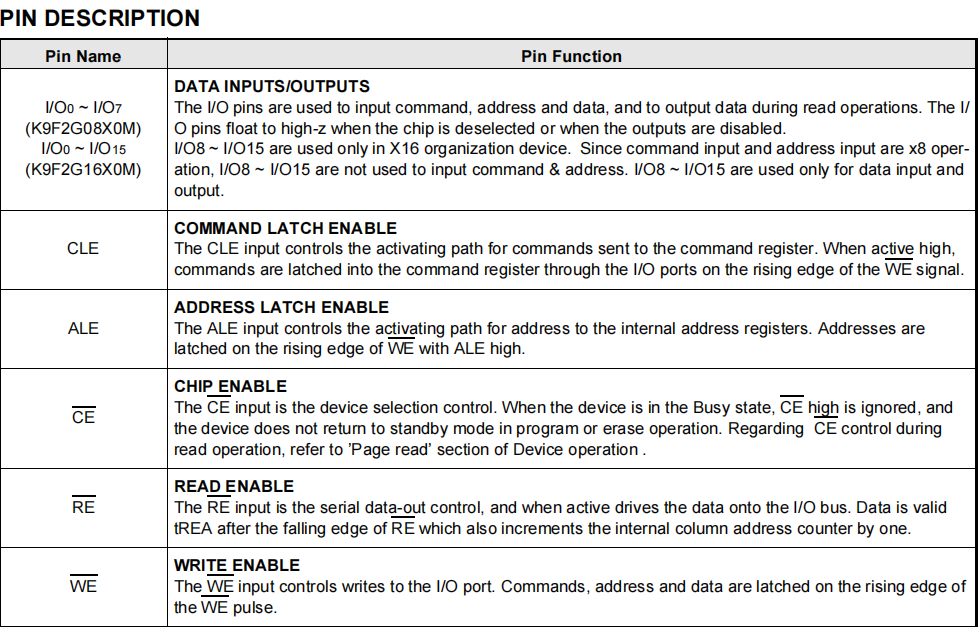

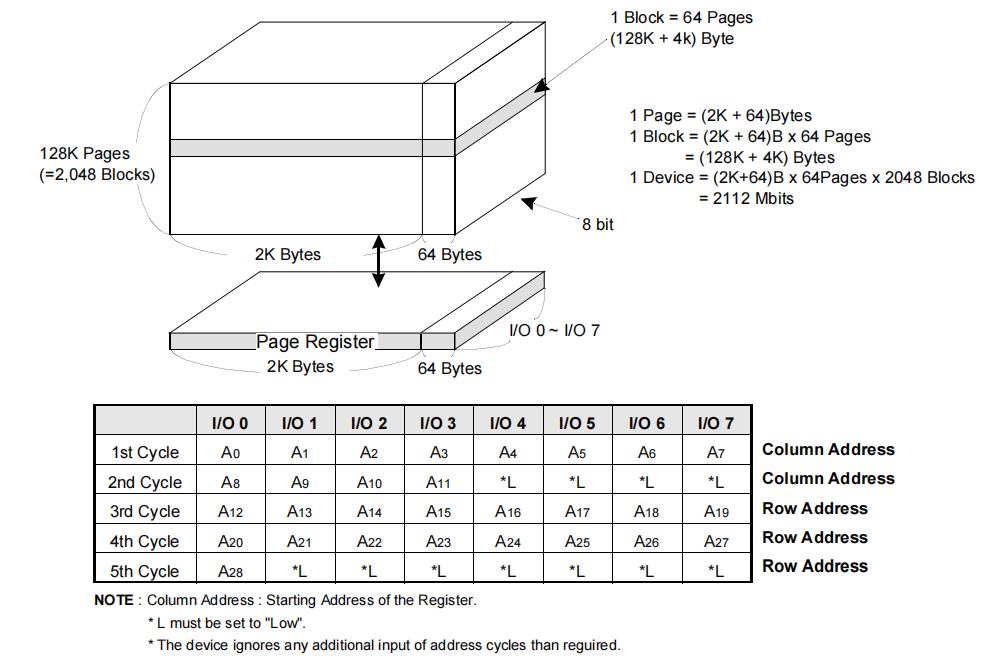
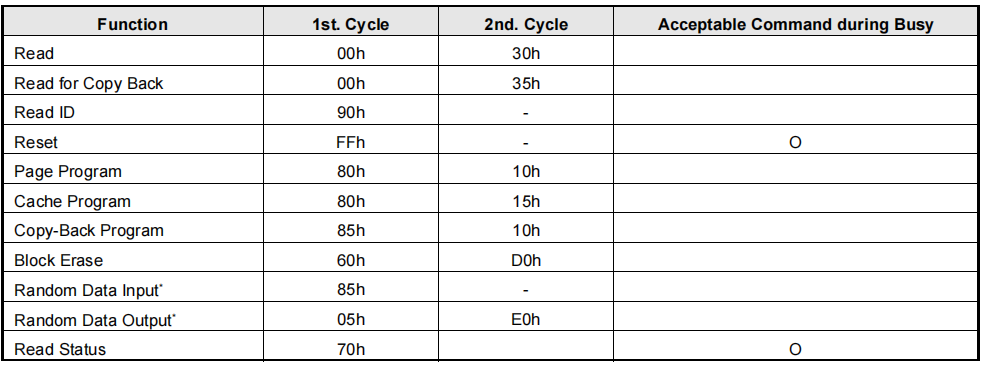
ECC(软件或硬件寄存器)
2KB存储数据,64用于管理功能(存储ECC数据、存储坏块标志···),
读取或写入前后会做校验,校验不通过则证明已损坏,会将坏块信息存储信息到Nand时会产生
ECC(校验信息)存储到64字节内,下次读写跳过坏块
Nand操作流程
坏块检查
nand使用前要擦除(块单位),擦除完后全是1,擦除后检测是否为0xff可知是否为坏块
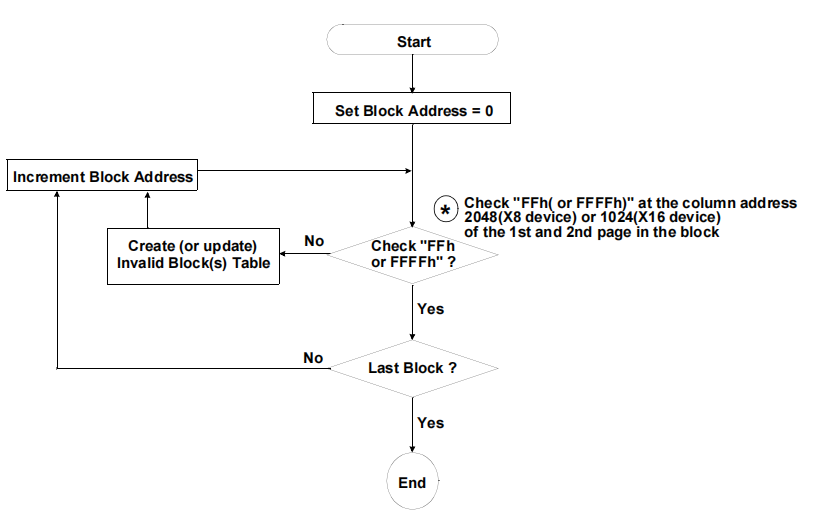
页写
写前需要擦除
SoC写Flash通过命令线在IO线依次发送写入开始命令、要写入的页地址、要写入数据,写入结束命令
SOC与Nand建立写入连接后,写入一页数据发给Nand接口,接口接收数据缓冲区,再写入Nand存储区
nand接收和写入数据需要延时,通过状态寄存器判断是否写完,写完后再发送写入结束命令,再做ECC校验写入是否正常
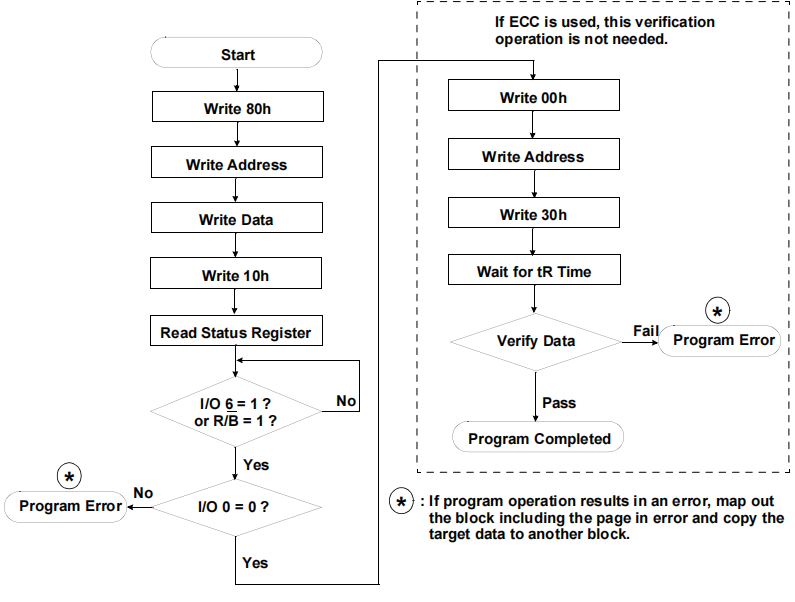
擦除
擦除读写要发送对齐地址
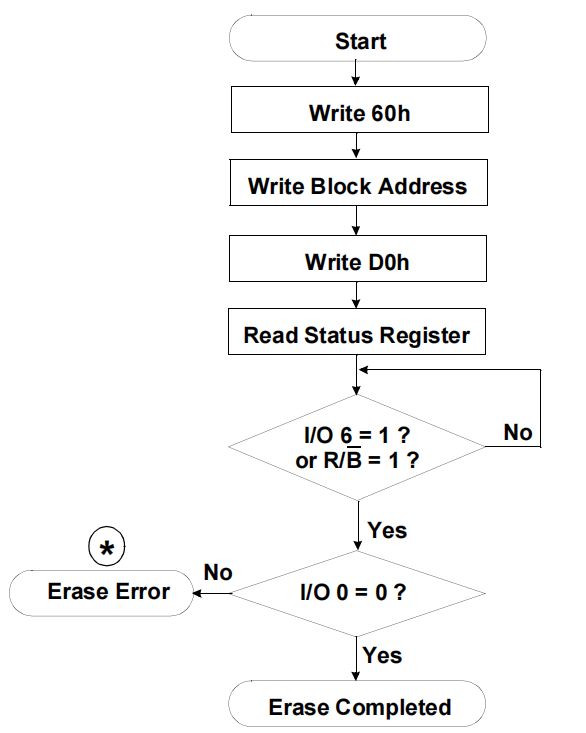
页读
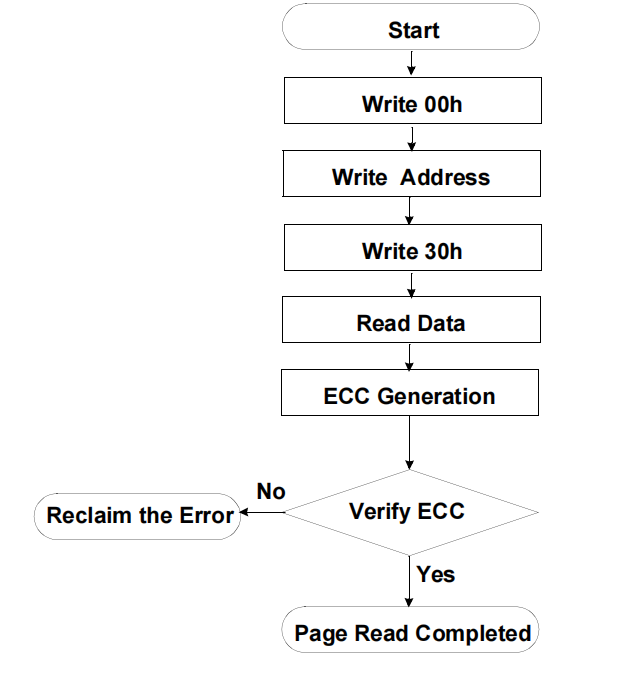
210Nand相关寄存器
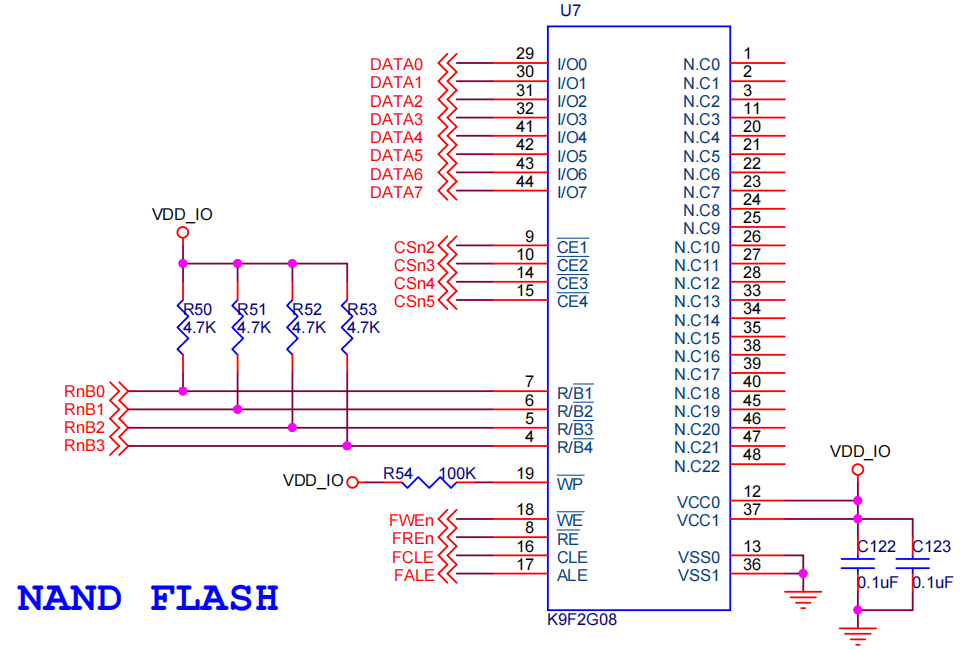

gpio
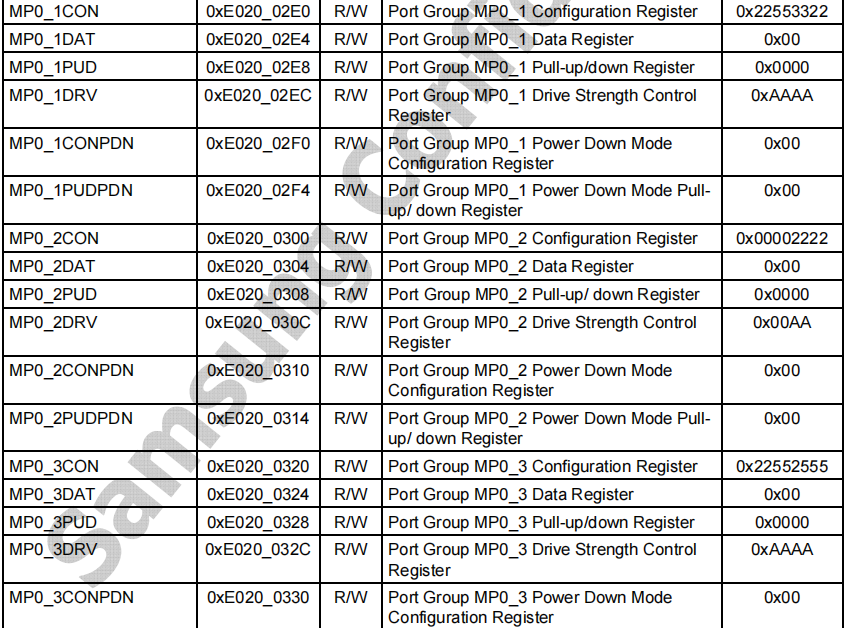
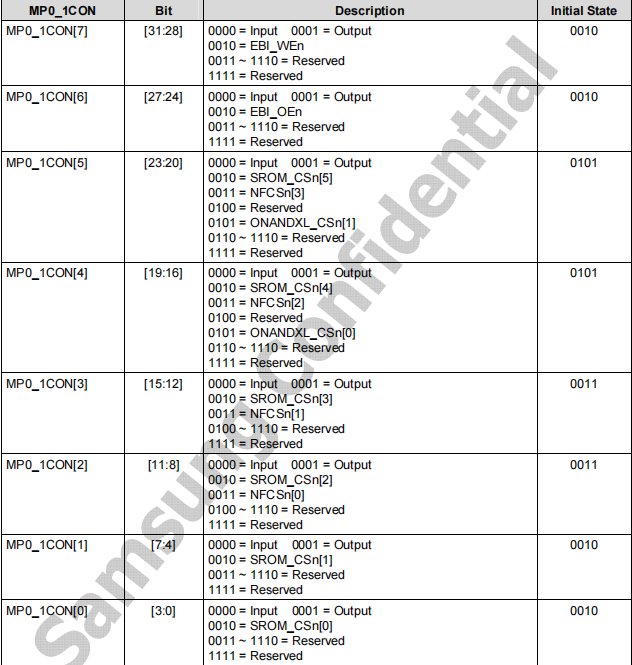



nand configure
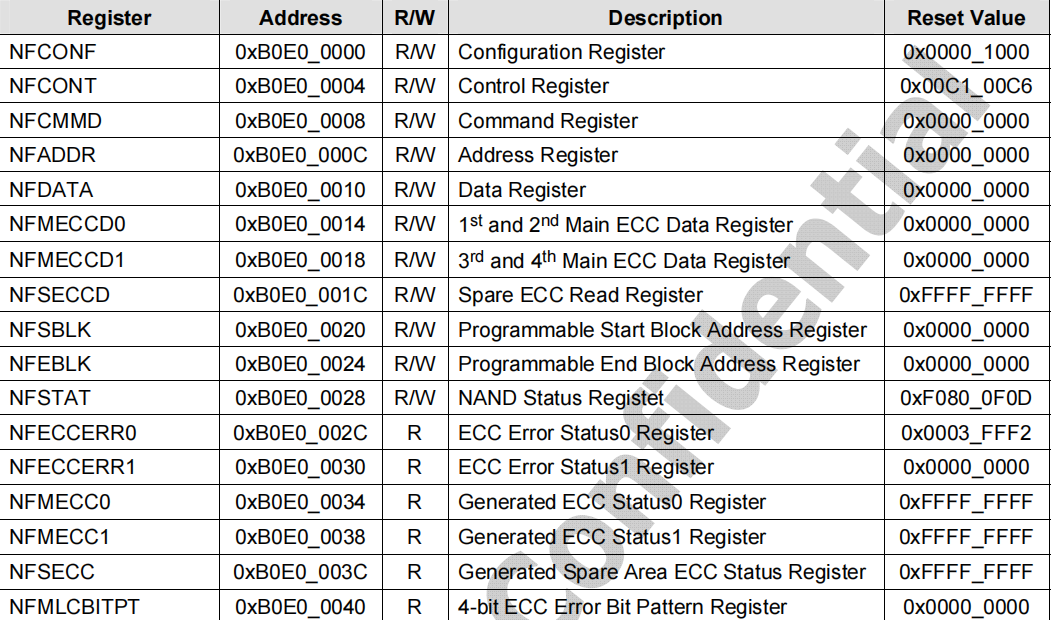


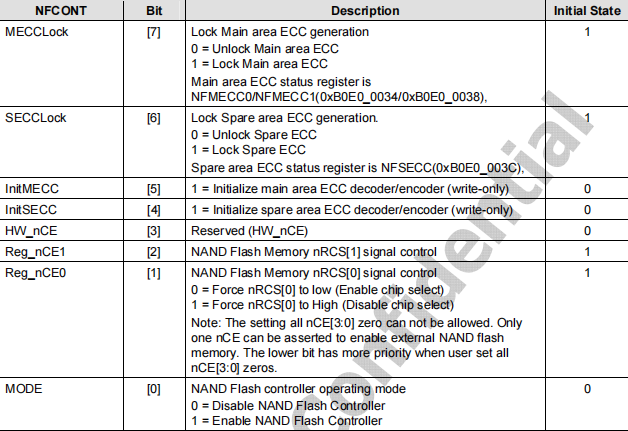


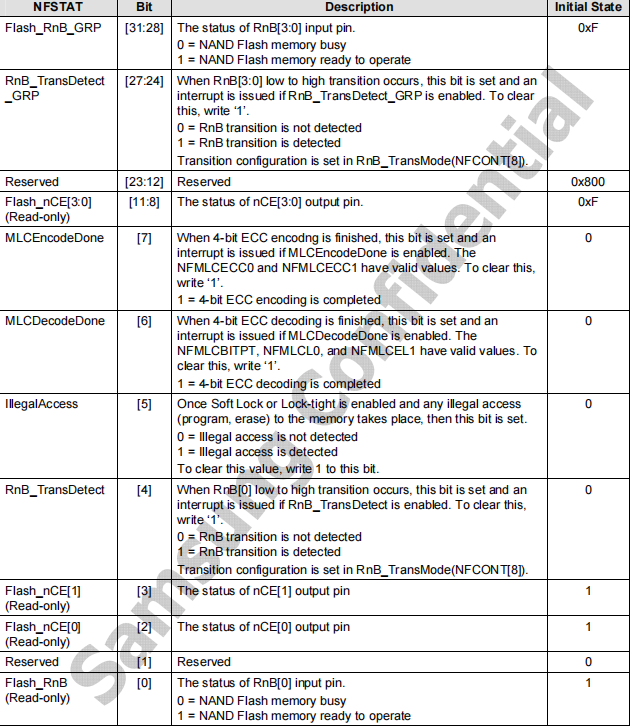
demo1:
nand功能
nand.h
void nand_init(void);
void nand_read_id(void);
int nand_block_erase(unsigned long block_num);
int copy_nand_to_sdram(unsigned char *sdram_addr, unsigned long nand_addr, unsigned long length);
int copy_sdram_to_nand(unsigned char *sdram_addr, unsigned long nand_addr, unsigned long length);
int nand_page_read(unsigned int pgaddr, unsigned char *buf, unsigned int length);
int nand_page_write(unsigned int pgaddr, const unsigned char *buf, unsigned int length);
int nand_random_read(unsigned long pgaddr,unsigned short offset, unsigned char *data);
int nand_random_write(unsigned long pgaddr,unsigned short offset,unsigned char wrdata);nand.c
#include "nand.h"
#include "stdio.h"
#define rNFCONF ( *((volatile unsigned long *)0xB0E00000) )
#define rNFCONT ( *((volatile unsigned long *)0xB0E00004) )
#define rNFCMMD ( *((volatile unsigned long *)0xB0E00008) )
#define rNFADDR ( *((volatile unsigned long *)0xB0E0000C) )
#define rNFDATA ( *((volatile unsigned long *)0xB0E00010) )
#define rNFDATA8 ( *((volatile unsigned char *)0xB0E00010) )
#define rNFSTAT ( *((volatile unsigned long *)0xB0E00028) )
#define rMP0_1CON ( *((volatile unsigned long *)0xE02002E0) )
#define rMP0_2CON ( *((volatile unsigned long *)0xE0200300) )
#define rMP0_3CON ( *((volatile unsigned long *)0xE0200320) )
#define MAX_NAND_BLOCK 8192
#define NAND_PAGE_SIZE 2048
#define NAND_BLOCK_SIZE 64
//dealy time(12ns)
#define TACLS 1
#define TWRPH0 4
#define TWRPH1 1
//command
#define NAND_CMD_READ_1st 0x00
#define NAND_CMD_READ_2st 0x30
#define NAND_CMD_READ_CB_1st 0x00
#define NAND_CMD_READ_CB_2st 0x35
#define NAND_CMD_RANDOM_WRITE 0x85
#define NAND_CMD_RANDOM_READ_1st 0x05
#define NAND_CMD_RANDOM_READ_2st 0xe0
#define NAND_CMD_READ_ID 0x90
#define NAND_CMD_RESET 0xff
#define NAND_CMD_READ_STATUS 0x70
#define NAND_CMD_WRITE_PAGE_1st 0x80
#define NAND_CMD_WRITE_PAGE_2st 0x10
#define NAND_CMD_BLOCK_ERASE_1st 0x60
#define NAND_CMD_BLOCK_ERASE_2st 0xd0
#define ECC_EN (1<<4)
#define CONTROL_EN (1<<0)
static void nand_reset(void);
static void nand_wait_idle(void);
static void nand_select_chip(void);
static void nand_deselect_chip(void);
static void nand_send_cmd(unsigned long cmd);
static void nand_send_addr(unsigned long addr);
static unsigned char nand_read8(void);
static void nand_write8(unsigned char data);
static unsigned int nand_read32(void);
static void nand_write32(unsigned int data);
typedef struct nand_id_info
{
//marker code
unsigned char IDm;
//device code
unsigned char IDd;
unsigned char ID3rd;
unsigned char ID4th;
unsigned char ID5th;
}nand_id_info;
//reset
void nand_reset(void)
{
nand_select_chip();
nand_send_cmd(NAND_CMD_RESET);
nand_wait_idle();
nand_deselect_chip();
}
//waite busy or read status over
void nand_wait_idle(void)
{
unsigned long i;
while( !(rNFSTAT & (1<<4)) )
for(i=0; i<10; i++);
}
//connect nand
void nand_select_chip(void)
{
unsigned long i;
rNFCONT &= ~(1<<1);
for(i=0; i<10; i++);
}
//disconnect nand
void nand_deselect_chip(void)
{
unsigned long i = 0;
rNFCONT |= (1<<1);
for(i=0; i<10; i++);
}
//send command
void nand_send_cmd(unsigned long cmd)
{
unsigned long i = 0;
rNFCMMD = cmd;
for(i=0; i<10; i++);
}
//send address
void nand_send_addr(unsigned long addr)
{
unsigned long i;
unsigned long col, row;
//address of interior page
col = addr % NAND_PAGE_SIZE;
//address of page
row = addr / NAND_PAGE_SIZE;
//write Column Address A0~A7
rNFADDR = col & 0xff;
for(i=0; i<10; i++);
//write Column Address A8~A11
rNFADDR = (col >> 8) & 0x0f;
for(i=0; i<10; i++);
//write Row Address A12~A19
rNFADDR = row & 0xff;
for(i=0; i<10; i++);
//write Row Address A20~A27
rNFADDR = (row >> 8) & 0xff;
for(i=0; i<10; i++);
//write Row Address A28~A30(A28,low level)
rNFADDR = (row >> 16) & 0xff;
for(i=0; i<10; i++);
}
//read nand(word)
unsigned int nand_read32(void)
{
return rNFDATA;
}
//write nand(word)
void nand_write32(unsigned int data)
{
rNFDATA = data;
}
//read nand(half word)
unsigned char nand_read8(void)
{
return rNFDATA8;
}
//write nand(half word)
void nand_write8(unsigned char data)
{
rNFDATA8 = data;
}
//get nand status
unsigned char nand_read_status(void)
{
unsigned char ch;
int i;
//connect nand
nand_select_chip();
//get nand status
nand_send_cmd(NAND_CMD_READ_STATUS);
for(i=0; i<10; i++);
//read nand
ch = nand_read8();
//disconnect nand
nand_deselect_chip();
return ch;
}
// nand init
void nand_init(void)
{
//set read nand signal dealy
rNFCONF = (TACLS<<12)|(TWRPH0<<8)|(TWRPH1<<4)|(0<<3)|(0<<2)|(1<<1)|(0<<0);
//set nand control,chip,set ECC,close read/busy status interrupt,close soft lock
rNFCONT = (0<<18)|(0<<17)|(0<<16)|(0<<10)|(0<<9)|(0<<8)|(0<<7)|(0<<6)|(0x3<<1)|(1<<0);
//set gpio nandflash
rMP0_1CON = 0x22333322;
rMP0_2CON = 0x00002222;
rMP0_3CON = 0x22222222;
//reset
nand_reset();
}
//get nand id
void nand_read_id(void)
{
nand_id_info nand_id;
//connect nand
nand_select_chip();
//get nand id
nand_send_cmd(NAND_CMD_READ_ID);
nand_send_addr(0x00);
nand_wait_idle();
nand_id.IDm = nand_read8();
nand_id.IDd = nand_read8();
nand_id.ID3rd = nand_read8();
nand_id.ID4th = nand_read8();
nand_id.ID5th = nand_read8();
printf("nandflash: makercode = %x\r\n devicecode = %x\r\n ID3rd = %x\r\n ID4rd = %x\r\n ID5rd = %x\r\n", nand_id.IDm, nand_id.IDd, nand_id.ID3rd, nand_id.ID4th, nand_id.ID5th);
//disconnect nand
nand_deselect_chip();
}
//earse the num of block(0 ~ MAX_NAND_BLOCK-1)
int nand_block_erase(unsigned long block_num)
{
unsigned long i = 0;
//get the starting page address of block(block starting address)
unsigned long row = block_num * NAND_BLOCK_SIZE;
//connect nand
nand_select_chip();
//send earse command (0x60)
nand_send_cmd(NAND_CMD_BLOCK_ERASE_1st);
//dealy time
for(i=0; i<10; i++);
//set erase address
//Row Address A12~A19
rNFADDR = row & 0xff;
for(i=0; i<10; i++);
// Row Address A20~A27
rNFADDR = (row >> 8) & 0xff;
for(i=0; i<10; i++);
// Row Address A28~A30
rNFADDR = (row >> 16) & 0xff;
//clear RnB bit,aim to send second command
rNFSTAT |= (1<<4);
//send second command(0xd0)
nand_send_cmd(NAND_CMD_BLOCK_ERASE_2st);
for(i=0; i<10; i++);
//waite busy or read status over
nand_wait_idle();
//judge read/busy status,0 earse success
unsigned char status = nand_read_status();
if (status & 1 )
{
//disconnect nand
nand_deselect_chip();
printf("masking bad block %d\r\n", block_num);
return -1;
}
else
{
nand_deselect_chip();
return 0;
}
}
//erase the address of nand
int nand_erase(unsigned long block_addr)
{
int i = 0;
//judge write protect
if((nand_read_status() & 0x80) == 0)
{
printf("Write protected.\n");
return -1;
}
unsigned long row = block_addr >> 18;
//connect nand
nand_select_chip();
// send erase command(0x60)
nand_send_cmd(NAND_CMD_BLOCK_ERASE_1st);
//dealy time
for(i=0; i<10; i++);
//set erase address
// Row Address A12~A19
rNFADDR = row & 0xff;
for(i=0; i<10; i++);
// Row Address A20~A27
rNFADDR = (row >> 8) & 0xff;
for(i=0; i<10; i++);
// Row Address A28~A30
rNFADDR = (row >> 16) & 0x01;
for(i=0; i<10; i++);
//clear RnB bit,aim to send second command
rNFSTAT |= (1<<4);
//send second command(0xd0)
nand_send_cmd(NAND_CMD_BLOCK_ERASE_2st);
for(i=0; i<10; i++);
//waite busy or read status over
nand_wait_idle();
//judge erase ,0 sucess
unsigned char status = nand_read_status();
if (status & 1)
{
nand_deselect_chip();
printf("masking bad block %d\r\n", block_addr);
return -1;
}
else
{
nand_deselect_chip();
return 0;
}
}
//copy nand to sdram
int copy_nand_to_sdram(unsigned char *sdram_addr, unsigned long nand_addr, unsigned long length)
{
unsigned long i = 0;
//connect nand
nand_select_chip();
while(length)
{
//send read command(0x00)
nand_send_cmd(NAND_CMD_READ_1st);
//send read starting address
nand_send_addr(nand_addr);
//clear RnB bit,aim to send second command
rNFSTAT = (rNFSTAT)|(1<<4);
//send second command (0x30)
nand_send_cmd(NAND_CMD_READ_2st);
//waite busy or read status over
nand_wait_idle();
//get the address of start page
unsigned long col = nand_addr % NAND_PAGE_SIZE;
i = col;
//read one page,pre one time copy 1byte,need 2048 times,when length equal 0 over
for(; i<NAND_PAGE_SIZE && length!=0; i++,length--)
{
*sdram_addr = nand_read8();
sdram_addr++;
nand_addr++;
}
}
//judge copy result
unsigned char status = nand_read_status();
if (status & 1 )
{
nand_deselect_chip();
printf("copy nand to sdram fail\r\n");
return -1;
}
else
{
nand_deselect_chip();
return 0;
}
}
//copy sdram to nand
int copy_sdram_to_nand(unsigned char *sdram_addr, unsigned long nand_addr, unsigned long length)
{
unsigned long i = 0;
//connect nand
nand_select_chip();
while(length)
{
//send write command(0x80)
nand_send_cmd(NAND_CMD_WRITE_PAGE_1st);
//send read starting address
nand_send_addr(nand_addr);
//get the address of start page
unsigned long col = nand_addr % NAND_PAGE_SIZE;
i = col;
//write one page,pre one time write 1byte,need 2048 times,when length equal 0 over
for(; i<NAND_PAGE_SIZE && length!=0; i++,length--)
{
nand_write8(*sdram_addr);
sdram_addr++;
nand_addr++;
}
//clear RnB bit,aim to send second command
rNFSTAT = (rNFSTAT)|(1<<4);
//send second command (0x10)
nand_send_cmd(NAND_CMD_WRITE_PAGE_2st);
//waite busy or read status over
nand_wait_idle();
}
//judge copy result
unsigned char status = nand_read_status();
if (status & 1 )
{
nand_deselect_chip();
printf("copy sdram to nand fail\r\n");
return -1;
}
else
{
nand_deselect_chip();
return 0;
}
}
//read bit on page
int nand_page_read(unsigned int pgaddr, unsigned char *buf, unsigned int length)
{
int i = 0;
//connect nand
nand_select_chip();
//send read command(0x00)
nand_send_cmd(NAND_CMD_READ_1st);
//set read address
rNFADDR = 0;
rNFADDR = 0;
rNFADDR = pgaddr&0xff;
rNFADDR = (pgaddr>>8)&0xff;
rNFADDR = (pgaddr>>16)&0xff;
//clear RnB bit,aim to send second command
rNFSTAT |= (1<<4);
//send second command(0x30)
nand_send_cmd(NAND_CMD_READ_2st);
//waite busy or read status over
nand_wait_idle();
//read 2KB data area and 64 spare area(1byte)
for (i=0; (i<NAND_PAGE_SIZE) && (length!=0); i++,length--)
*buf++ = nand_read8();
//judge read result
unsigned char status = nand_read_status();
if (status & 1 )
{
nand_deselect_chip();
printf("nand random read fail\r\n");
return -1;
}
else
{
nand_deselect_chip();
return 0;
}
}
//read word on page
int nand_page_read32(unsigned int pgaddr, unsigned int *buf, unsigned int lengthB)
{
int i = 0;
//connect nand
nand_select_chip();
//send read command
nand_send_cmd(NAND_CMD_READ_1st);
//write read starting address
rNFADDR = 0;
rNFADDR = 0;
rNFADDR = pgaddr&0xff;
rNFADDR = (pgaddr>>8)&0xff;
rNFADDR = (pgaddr>>16)&0xff;
//clear RnB bit,aim to send second command
rNFSTAT |= (1<<4);
//send second command(0x30)
nand_send_cmd(NAND_CMD_READ_2st);
//waite busy or read status over
nand_wait_idle();
//read 2KB + 64B spare area(1 word)
for (i=0; (i<NAND_PAGE_SIZE/4) && (lengthB!=0); i++,lengthB--)
*buf++ = nand_read32();
//judge read result
unsigned char status = nand_read_status();
if (status & 1 )
{
nand_deselect_chip();
printf("nand random read fail\r\n");
return -1;
}
else
{
nand_deselect_chip();
return 0;
}
}
//write page
int nand_page_write(unsigned int pgaddr, const unsigned char *buf, unsigned int length)
{
int i = 0;
//connect nand
nand_select_chip();
//send write command(0x80)
nand_send_cmd(NAND_CMD_WRITE_PAGE_1st);
//write start address
rNFADDR = 0;
rNFADDR = 0;
rNFADDR = pgaddr&0xff;
rNFADDR = (pgaddr>>8)&0xff;
rNFADDR = (pgaddr>>16)&0xff;
//write page(1byte)
for(; i<NAND_PAGE_SIZE && length!=0; i++,length--)
nand_write8(*buf++);
//clear RnB bit,aim to send second command
rNFSTAT = (rNFSTAT)|(1<<4);
//sens second command
nand_send_cmd(NAND_CMD_WRITE_PAGE_2st);
//wait busy or read status over
nand_wait_idle();
//judge write result
unsigned char status = nand_read_status();
if (status & 1 )
{
nand_deselect_chip();
printf("nand random write fail\r\n");
return -1;
}
else
{
nand_deselect_chip();
return 0;
}
}
//read random
int nand_random_read(unsigned long pgaddr,unsigned short offset, unsigned char *data)
{
unsigned char readdata;
//connect nand
nand_select_chip();
//send read command(0x00)
nand_send_cmd(NAND_CMD_READ_1st);
//write start address
rNFADDR = 0;
rNFADDR = 0;
rNFADDR = pgaddr&0xff;
rNFADDR = (pgaddr>>8)&0xff;
rNFADDR = (pgaddr>>16)&0xff;
//clear RnB bit,aim to send second command
rNFSTAT |= (1<<4);
//second second command
nand_send_cmd(NAND_CMD_READ_2st);
//wait busy or read status over
nand_wait_idle();
//send read command(0x05)
nand_send_cmd(NAND_CMD_RANDOM_READ_1st);
//write the address of page that offset address
rNFADDR = offset&0xff;
rNFADDR = (offset>>8)&0xff;
//clear RnB bit,aim to send second command
rNFSTAT = (rNFSTAT)|(1<<4);
//second second command(0xe0)
nand_send_cmd(NAND_CMD_RANDOM_READ_2st);
//read data
readdata = nand_read8();
//judge read result
unsigned char status = nand_read_status();
if (status & 1 )
{
nand_deselect_chip();
printf("nand random read fail\r\n");
return -1;
}
else
{
nand_deselect_chip();
*data = readdata;
return 0;
}
}
//random write
int nand_random_write(unsigned long pgaddr,unsigned short offset,unsigned char wrdata)
{
//connect nand
nand_select_chip();
//send write command(0x80)
nand_send_cmd(NAND_CMD_WRITE_PAGE_1st);
//write start address
rNFADDR = 0;
rNFADDR = 0;
rNFADDR = pgaddr&0xff;
rNFADDR = (pgaddr>>8)&0xff;
rNFADDR = (pgaddr>>16)&0xff;
//send write command (0x80)
nand_send_cmd(NAND_CMD_RANDOM_WRITE);
//write the address of page that offset address
rNFADDR = offset&0xff;
rNFADDR = (offset>>8)&0xff;
//write data(1byte)
nand_write8(wrdata);
//clear RnB bit,aim to send second command
rNFSTAT = (rNFSTAT)|(1<<4);
//send second command
nand_send_cmd(NAND_CMD_WRITE_PAGE_2st);
//wait busy or read status over
nand_wait_idle();
//judge write result
unsigned char status = nand_read_status();
if (status & 1 )
{
nand_deselect_chip();
printf("nand random write fail\r\n");
return -1;
}
else
{
nand_deselect_chip();
return 0;
}
}
iNand
iNand/eMMC/SDCard/MMCCard
mmc对于nandflash的优势:卡片化便于拆装,接口协议Hmmc协议)统一便于封装
SD卡(SD协议、SPI协议)兼容性好且有写保护、速率快、容量大
iNand/eMMC与NandFlash
iNand和nand内部由存储和接口组成
iNand接口支持eMMC协议、ECC校验,使用ML,有cache 机制,速度快
NandFlash:SLC 更稳定,容量小价格高;MLC易出错容量大价格低
SD/iNand/eMMC
210是4通道SD/MMC,SD/MMC0接iNand,SD/MMC2-3接SD卡
SD卡是4IO线支持1、4、8线并行传输,iNand是8IO线支持1、4线并行传输
硬件接口:DATA(数据)、CLK(时钟,25Mhz)、CMD(命令)
SD协议是多标准命令,命令有使用条件和响应,少数命令没有响应
SD卡命令是周期性组合(组合命令),在命令周期中,发送CMD到SD卡,SD卡执行命令并且返回响应,主机接收响应后再发下一条
CMD和ACMD:SD协议命令:CMDx、ACMDx;CMD是单命令,ACMDy = CMDy + CMDz(y一般是55)
SD卡处于某种状态(空闲状态、准备好状态、读写状态、出错状态····),接受某种执行命令(跳转命令)并返回响应,跳转到另一状态
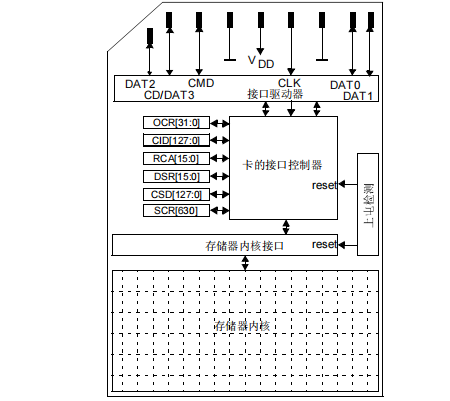
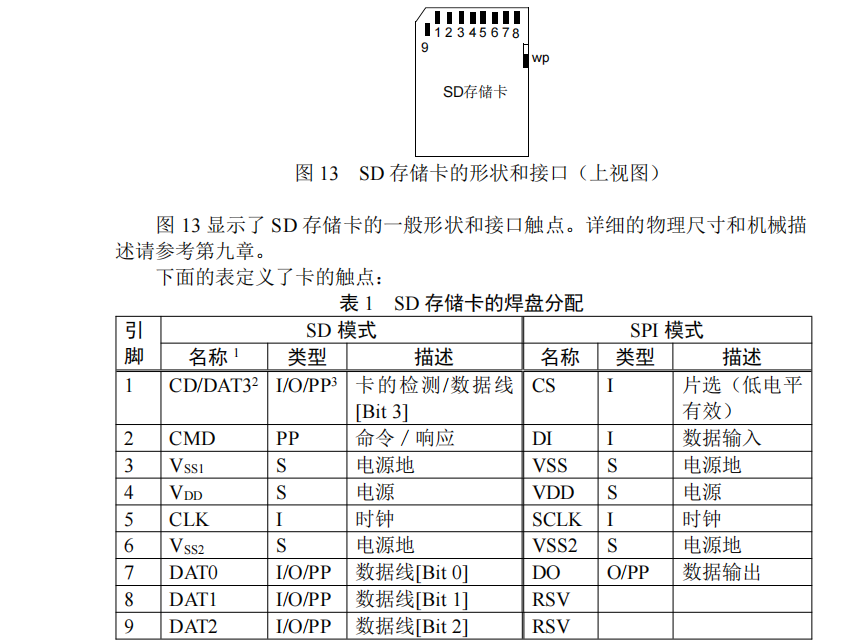



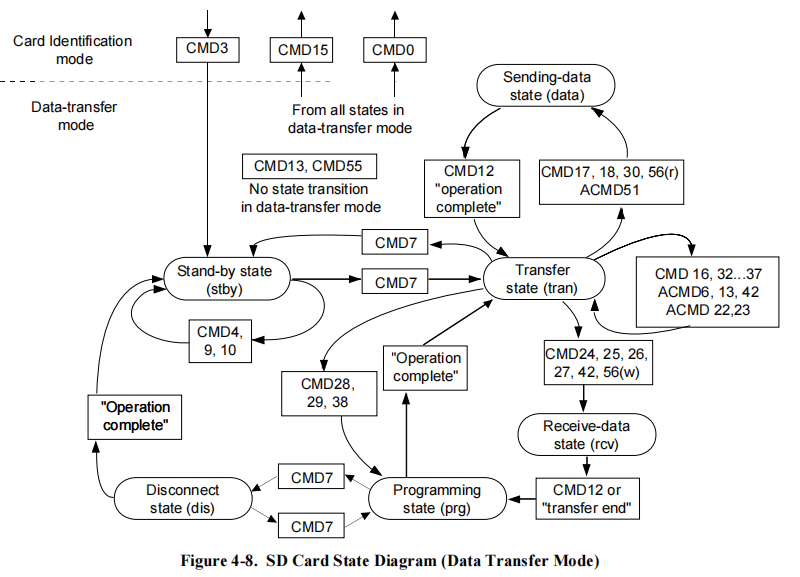

210SD/iNand寄存器
RCA(相对地址寄存器)
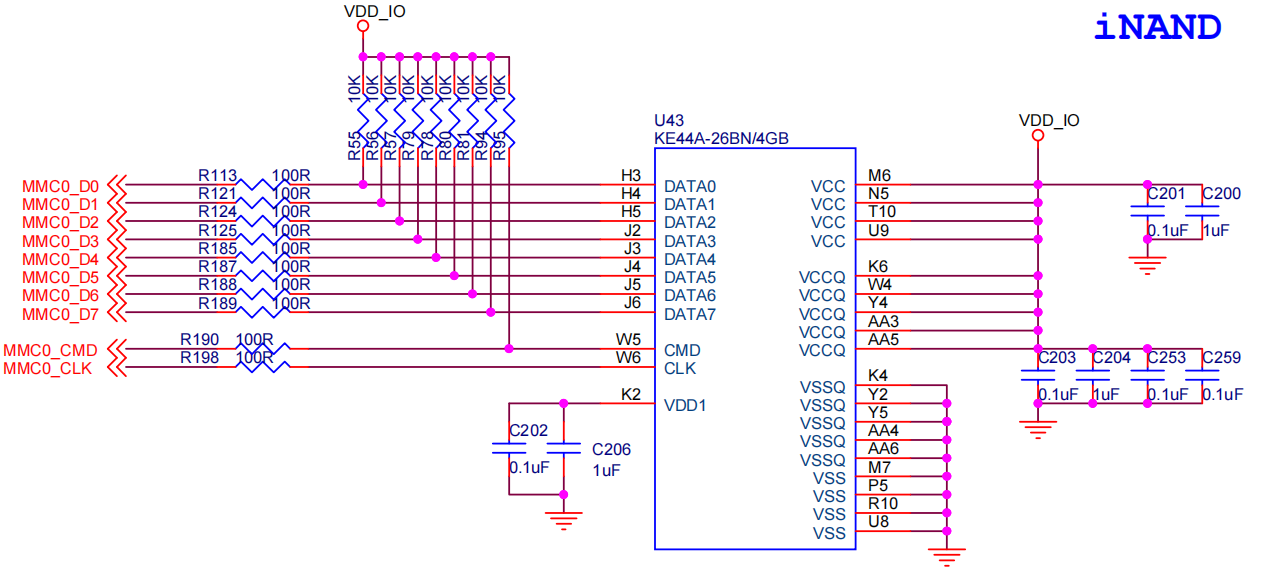
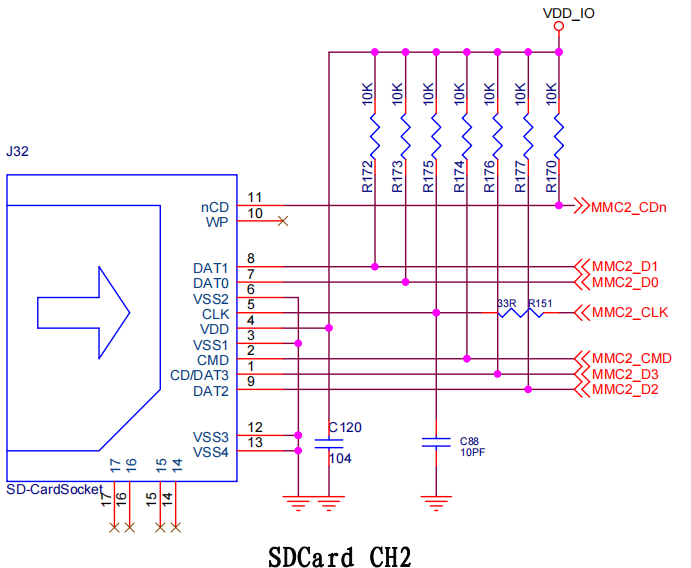
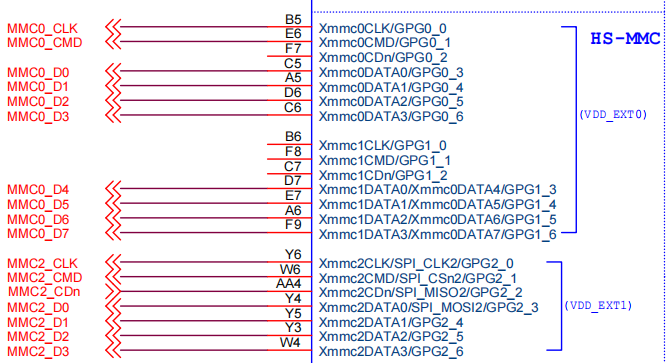
gpio

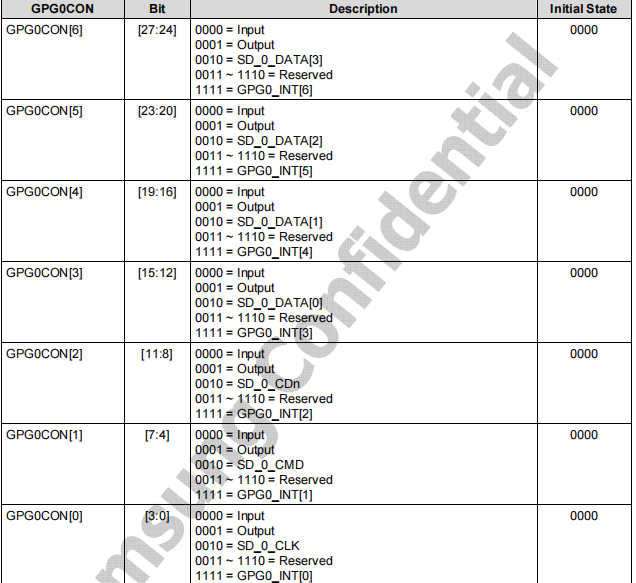
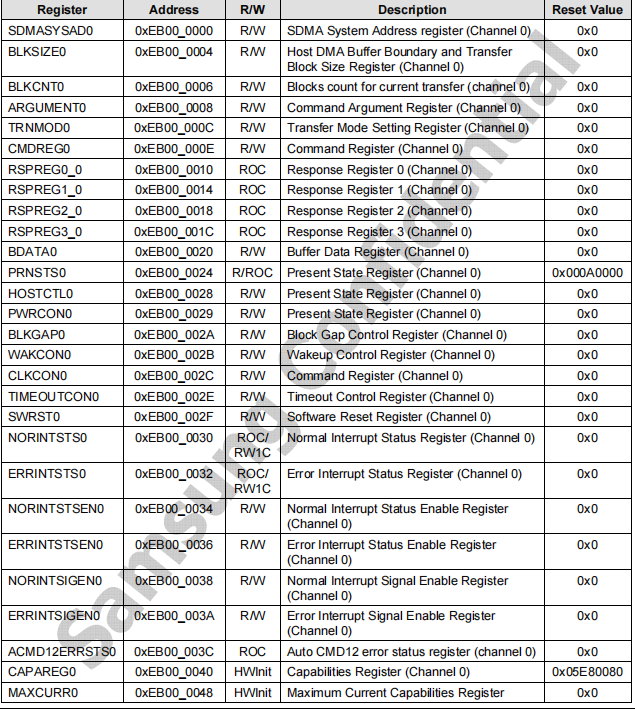

设置时钟
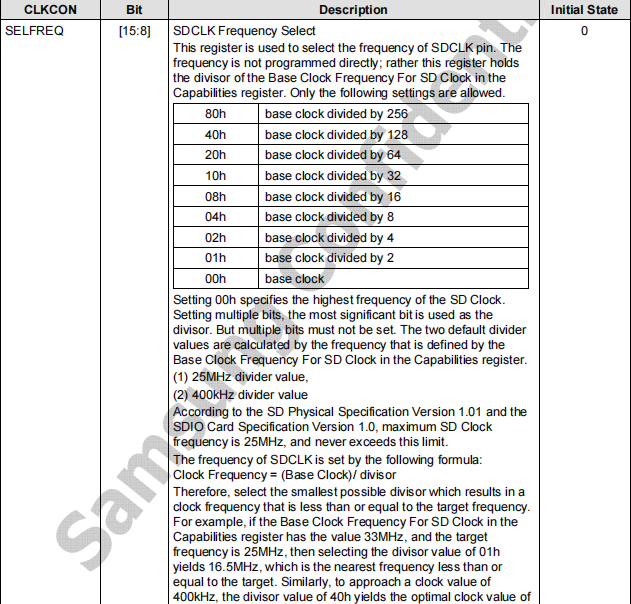
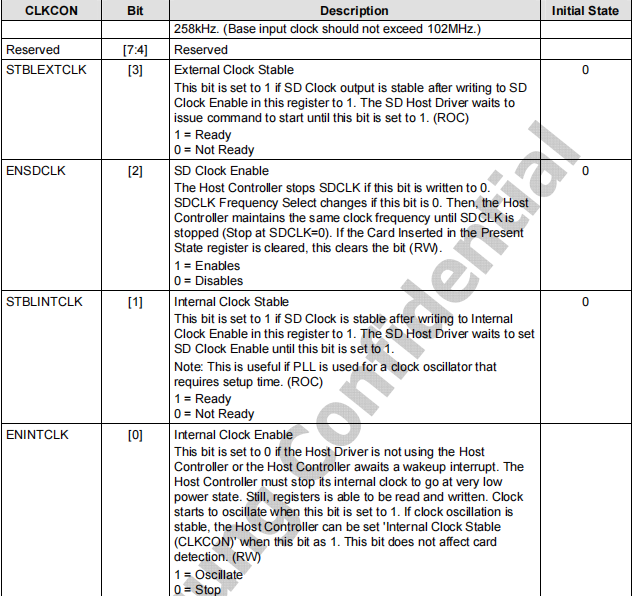
状态寄存器(命令,写入,读取,中断...)

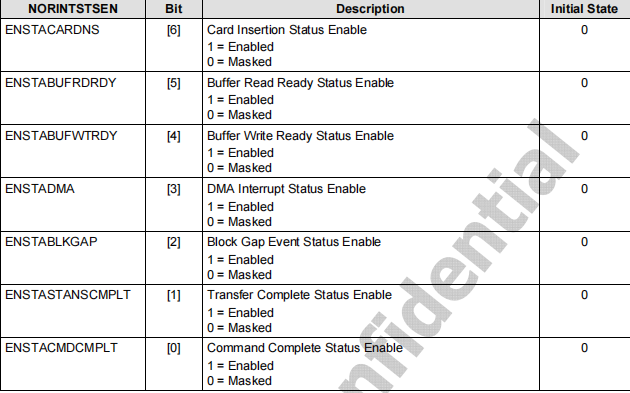
cmd

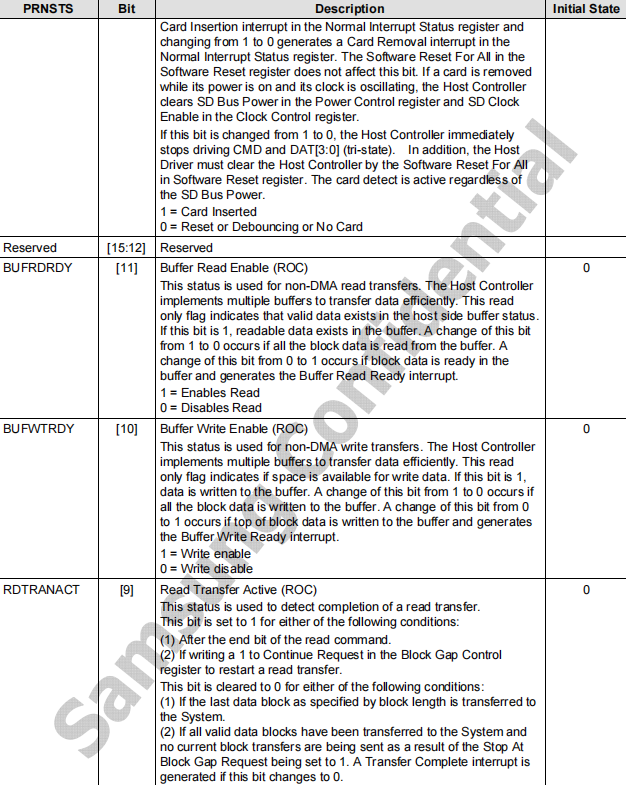
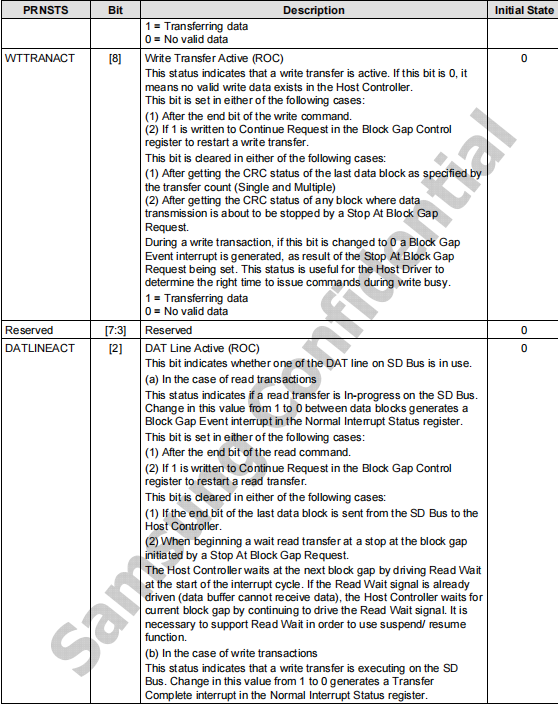
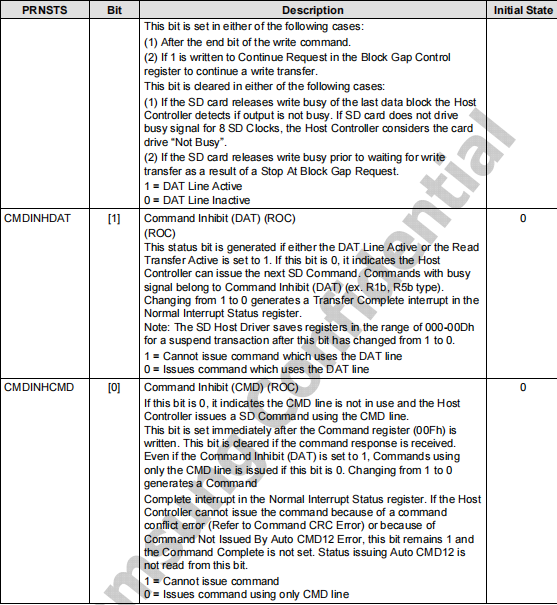
命令参数

错误状态
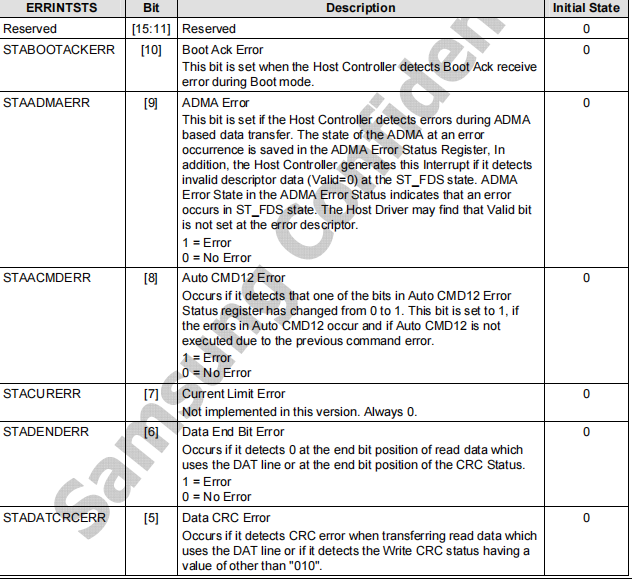
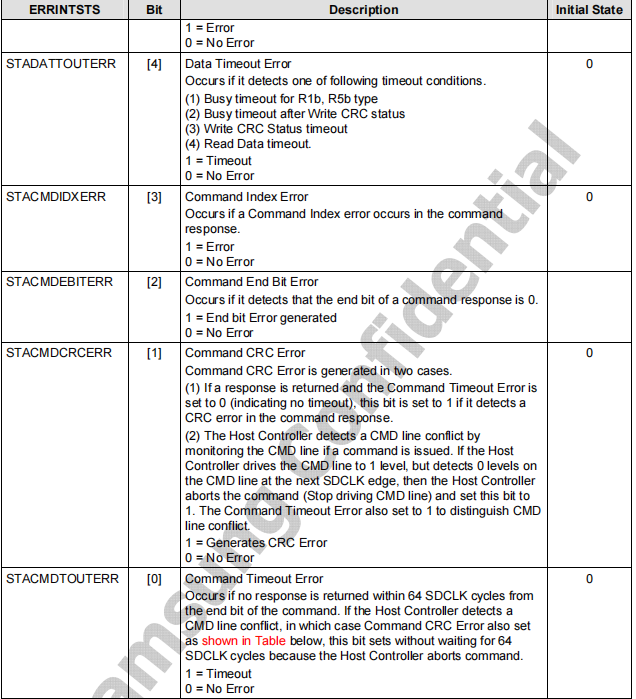
设置每次读取block大小
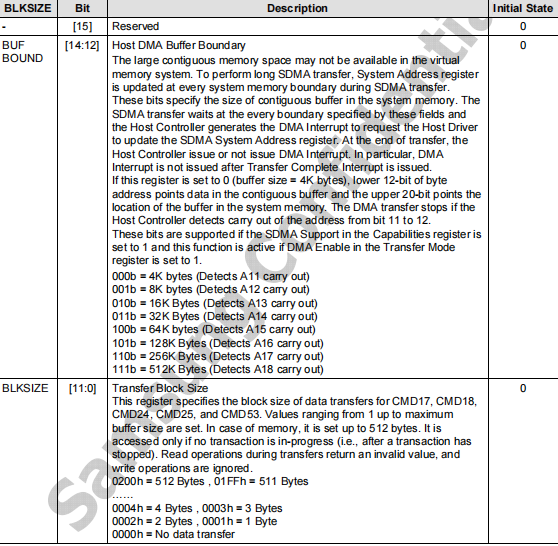
设置每次读取block数量
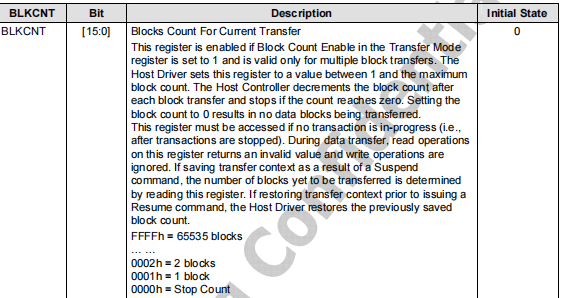
配置数据传输
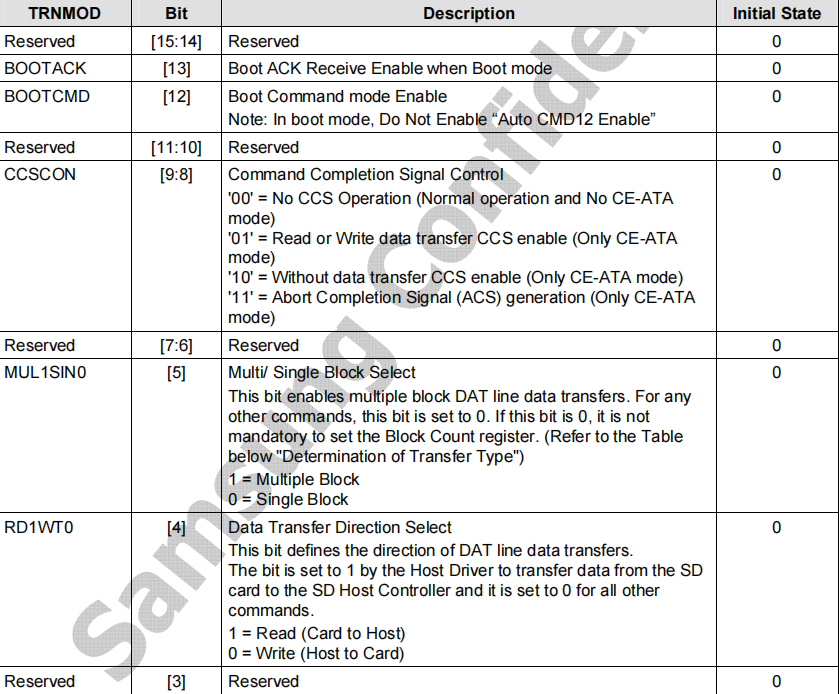
命令控制寄存器
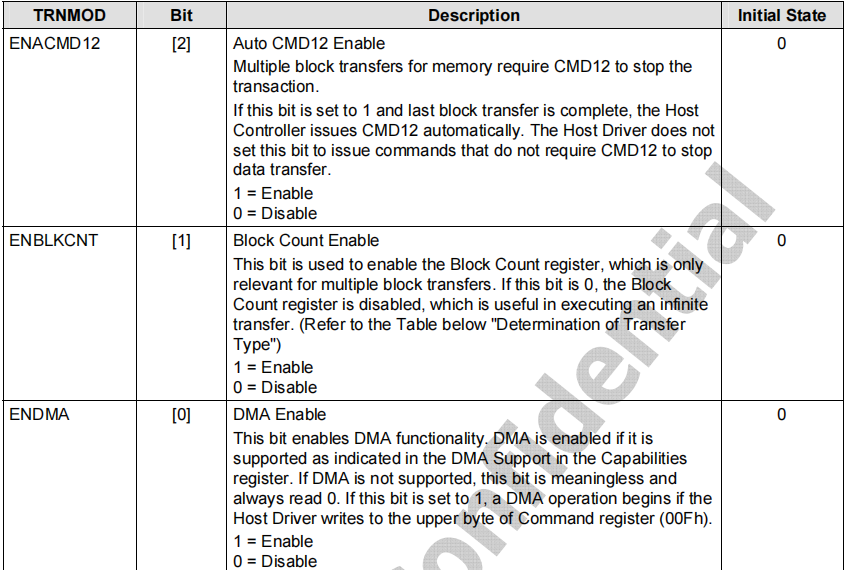

32位数据端口寄存器访问内部缓冲区

sd响应

设置中断状态


sd命令参数
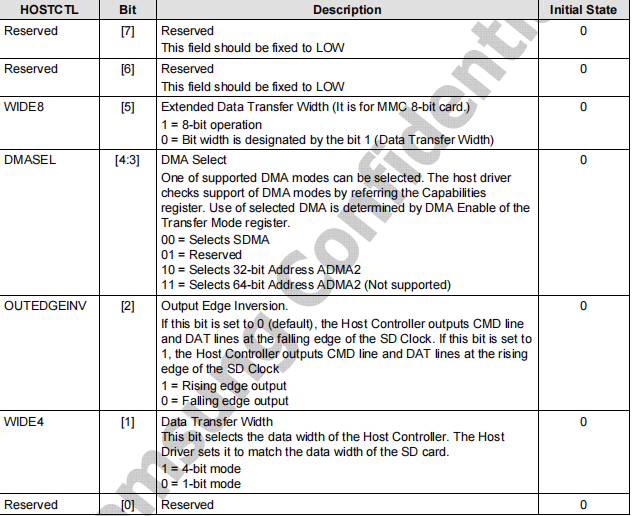
设置软件功能(是SD不是soc)
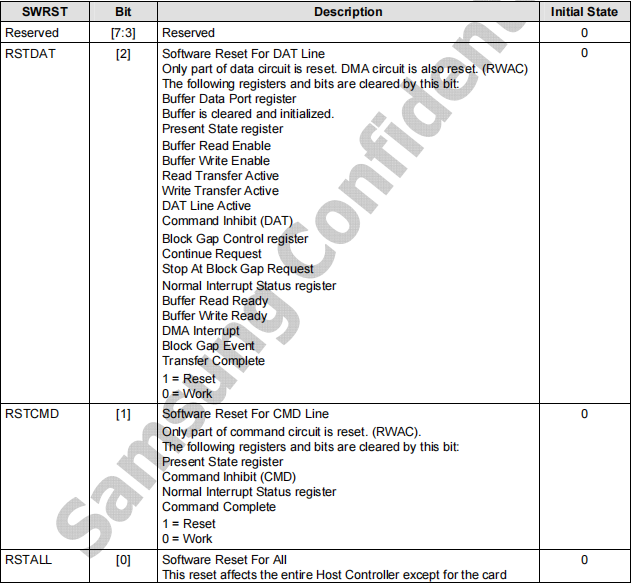
设置超时
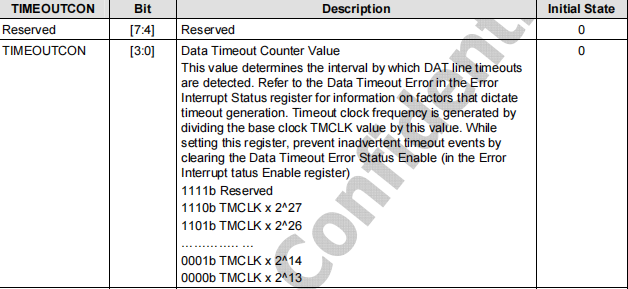
设置错误中断状态

demo2:
sd/emmc功能
Hsmmc.h
#ifndef __HSMMC_H__
#define __HSMMC_H__
#ifdef __cplusplus
extern "C" {
#endif
#include "stdint.h"
// SD协议规定的命令码
#define CMD0 0
#define CMD1 1
#define CMD2 2
#define CMD3 3
#define CMD6 6
#define CMD7 7
#define CMD8 8
#define CMD9 9
#define CMD13 13
#define CMD16 16
#define CMD17 17
#define CMD18 18
#define CMD23 23
#define CMD24 24
#define CMD25 25
#define CMD32 32
#define CMD33 33
#define CMD38 38
#define CMD41 41
#define CMD51 51
#define CMD55 55
// 卡类型
#define UNUSABLE 0
#define SD_V1 1
#define SD_V2 2
#define SD_HC 3
#define MMC 4
// 卡状态
#define CARD_IDLE 0 // 空闲态
#define CARD_READY 1 // 准备好
#define CARD_IDENT 2
#define CARD_STBY 3
#define CARD_TRAN 4
#define CARD_DATA 5
#define CARD_RCV 6
#define CARD_PRG 7 // 卡编程状态
#define CARD_DIS 8 // 断开连接
// 卡回复类型
#define CMD_RESP_NONE 0 // 无回复
#define CMD_RESP_R1 1
#define CMD_RESP_R2 2
#define CMD_RESP_R3 3
#define CMD_RESP_R4 4
#define CMD_RESP_R5 5
#define CMD_RESP_R6 6
#define CMD_RESP_R7 7
#define CMD_RESP_R1B 8
typedef struct {
uint32_t RESERVED1;
uint32_t RESERVED2 : 16;
uint32_t SD_BUS_WIDTHS : 4;
uint32_t SD_SECURITY : 3;
uint32_t DATA_STAT_AFTER_ERASE : 1;
uint32_t SD_SPEC : 4;
uint32_t SCR_STRUCTURE : 4;
} SD_SCR;
int32_t Hsmmc_Init(void);
int32_t Hsmmc_GetCardState(void);
int32_t Hsmmc_GetSdState(uint8_t *pStatus);
int32_t Hsmmc_Get_SCR(SD_SCR *pSCR);
int32_t Hsmmc_Get_CSD(uint8_t *pCSD);
int32_t Hsmmc_EraseBlock(uint32_t StartBlock, uint32_t EndBlock);
int32_t Hsmmc_WriteBlock(uint8_t *pBuffer, uint32_t BlockAddr, uint32_t BlockNumber);
int32_t Hsmmc_ReadBlock(uint8_t *pBuffer, uint32_t BlockAddr, uint32_t BlockNumber);
#ifdef __cplusplus
}
#endif
#endif /*__HSMMC_H__*/
Hsmmc.c
#include "ProjectConfig.h"
#include "Hsmmc.h"
#define HSMMC_NUM 2
#if (HSMMC_NUM == 0)
#define HSMMC_BASE (0xEB000000)
#elif (HSMMC_NUM == 1)
#define HSMMC_BASE (0xEB100000)
#elif (HSMMC_NUM == 2)
#define HSMMC_BASE (0xEB200000)
#elif (HSMMC_NUM == 3)
#define HSMMC_BASE (0xEB300000)
#else
#error "Configure HSMMC: HSMMC0 ~ HSMM3(0 ~ 3)"
#endif
#define MAX_BLOCK 65535
#define SWRST_OFFSET 0x2F
static uint8_t CardType; // 卡类型
static uint32_t RCA; // 卡相对地址
static void Hsmmc_ClockOn(uint8_t On)
{
uint32_t Timeout;
if (On) {
__REGw(HSMMC_BASE+CLKCON_OFFSET) |= (1<<2); // sd时钟使能
Timeout = 1000; // Wait max 10 ms
while (!(__REGw(HSMMC_BASE+CLKCON_OFFSET) & (1<<3))) {
// 等待SD输出时钟稳定
if (Timeout == 0) {
return;
}
Timeout--;
Delay_us(10);
}
} else {
__REGw(HSMMC_BASE+CLKCON_OFFSET) &= ~(1<<2); // sd时钟禁止
}
}
static void Hsmmc_SetClock(uint32_t Clock)
{
uint32_t Temp;
uint32_t Timeout;
uint32_t i;
Hsmmc_ClockOn(0); // 关闭时钟
Temp = __REG(HSMMC_BASE+CONTROL2_OFFSET);
// Set SCLK_MMC(48M) from SYSCON as a clock source
Temp = (Temp & (~(3<<4))) | (2<<4);
Temp |= (1u<<31) | (1u<<30) | (1<<8);
if (Clock <= 500000) {
Temp &= ~((1<<14) | (1<<15));
__REG(HSMMC_BASE+CONTROL3_OFFSET) = 0;
} else {
Temp |= ((1<<14) | (1<<15));
__REG(HSMMC_BASE+CONTROL3_OFFSET) = (1u<<31) | (1<<23);
}
__REG(HSMMC_BASE+CONTROL2_OFFSET) = Temp;
for (i=0; i<=8; i++) {
if (Clock >= (48000000/(1<<i))) {
break;
}
}
Temp = ((1<<i) / 2) << 8; // clock div
Temp |= (1<<0); // Internal Clock Enable
__REGw(HSMMC_BASE+CLKCON_OFFSET) = Temp;
Timeout = 1000; // Wait max 10 ms
while (!(__REGw(HSMMC_BASE+CLKCON_OFFSET) & (1<<1))) {
// 等待内部时钟振荡稳定
if (Timeout == 0) {
return;
}
Timeout--;
Delay_us(10);
}
Hsmmc_ClockOn(1); // 使能时钟
}
static int32_t Hsmmc_WaitForBufferReadReady(void)
{
int32_t ErrorState;
while (1) {
if (__REGw(HSMMC_BASE+NORINTSTS_OFFSET) & (1<<15)) { // 出现错误
break;
}
if (__REGw(HSMMC_BASE+NORINTSTS_OFFSET) & (1<<5)) { // 读缓存准备好
__REGw(HSMMC_BASE+NORINTSTS_OFFSET) |= (1<<5); // 清除准备好标志
return 0;
}
}
ErrorState = __REGw(HSMMC_BASE+ERRINTSTS_OFFSET) & 0x1ff; // 可能通信错误,CRC检验错误,超时等
__REGw(HSMMC_BASE+NORINTSTS_OFFSET) = __REGw(HSMMC_BASE+NORINTSTS_OFFSET); // 清除中断标志
__REGw(HSMMC_BASE+ERRINTSTS_OFFSET) = __REGw(HSMMC_BASE+ERRINTSTS_OFFSET); // 清除错误中断标志
Debug("Read buffer error, NORINTSTS: %04x\r\n", ErrorState);
return ErrorState;
}
static int32_t Hsmmc_WaitForBufferWriteReady(void)
{
int32_t ErrorState;
while (1) {
if (__REGw(HSMMC_BASE+NORINTSTS_OFFSET) & (1<<15)) { // 出现错误
break;
}
if (__REGw(HSMMC_BASE+NORINTSTS_OFFSET) & (1<<4)) { // 写缓存准备好
__REGw(HSMMC_BASE+NORINTSTS_OFFSET) |= (1<<4); // 清除准备好标志
return 0;
}
}
ErrorState = __REGw(HSMMC_BASE+ERRINTSTS_OFFSET) & 0x1ff; // 可能通信错误,CRC检验错误,超时等
__REGw(HSMMC_BASE+NORINTSTS_OFFSET) = __REGw(HSMMC_BASE+NORINTSTS_OFFSET); // 清除中断标志
__REGw(HSMMC_BASE+ERRINTSTS_OFFSET) = __REGw(HSMMC_BASE+ERRINTSTS_OFFSET); // 清除错误中断标志
Debug("Write buffer error, NORINTSTS: %04x\r\n", ErrorState);
return ErrorState;
}
static int32_t Hsmmc_WaitForCommandDone(void)
{
uint32_t i;
int32_t ErrorState;
// 等待命令发送完成
for (i=0; i<0x20000000; i++) {
if (__REGw(HSMMC_BASE+NORINTSTS_OFFSET) & (1<<15)) { // 出现错误
break;
}
if (__REGw(HSMMC_BASE+NORINTSTS_OFFSET) & (1<<0)) {
do {
__REGw(HSMMC_BASE+NORINTSTS_OFFSET) = (1<<0); // 清除命令完成位
} while (__REGw(HSMMC_BASE+NORINTSTS_OFFSET) & (1<<0));
return 0; // 命令发送成功
}
}
ErrorState = __REGw(HSMMC_BASE+ERRINTSTS_OFFSET) & 0x1ff; // 可能通信错误,CRC检验错误,超时等
__REGw(HSMMC_BASE+NORINTSTS_OFFSET) = __REGw(HSMMC_BASE+NORINTSTS_OFFSET); // 清除中断标志
__REGw(HSMMC_BASE+ERRINTSTS_OFFSET) = __REGw(HSMMC_BASE+ERRINTSTS_OFFSET); // 清除错误中断标志
do {
__REGw(HSMMC_BASE+NORINTSTS_OFFSET) = (1<<0); // 清除命令完成位
} while (__REGw(HSMMC_BASE+NORINTSTS_OFFSET) & (1<<0));
Debug("Command error, ERRINTSTS = 0x%x ", ErrorState);
return ErrorState; // 命令发送出错
}
static int32_t Hsmmc_WaitForTransferDone(void)
{
int32_t ErrorState;
uint32_t i;
// 等待数据传输完成
for (i=0; i<0x20000000; i++) {
if (__REGw(HSMMC_BASE+NORINTSTS_OFFSET) & (1<<15)) { // 出现错误
break;
}
if (__REGw(HSMMC_BASE+NORINTSTS_OFFSET) & (1<<1)) { // 数据传输完
do {
__REGw(HSMMC_BASE+NORINTSTS_OFFSET) |= (1<<1); // 清除传输完成位
} while (__REGw(HSMMC_BASE+NORINTSTS_OFFSET) & (1<<1));
return 0;
}
}
ErrorState = __REGw(HSMMC_BASE+ERRINTSTS_OFFSET) & 0x1ff; // 可能通信错误,CRC检验错误,超时等
__REGw(HSMMC_BASE+NORINTSTS_OFFSET) = __REGw(HSMMC_BASE+NORINTSTS_OFFSET); // 清除中断标志
__REGw(HSMMC_BASE+ERRINTSTS_OFFSET) = __REGw(HSMMC_BASE+ERRINTSTS_OFFSET); // 清除错误中断标志
Debug("Transfer error, rHM1_ERRINTSTS = 0x%04x\r\n", ErrorState);
do {
__REGw(HSMMC_BASE+NORINTSTS_OFFSET) = (1<<1); // 出错后清除数据完成位
} while (__REGw(HSMMC_BASE+NORINTSTS_OFFSET) & (1<<1));
return ErrorState; // 数据传输出错
}
static int32_t Hsmmc_IssueCommand(uint8_t Cmd, uint32_t Arg, uint8_t Data, uint8_t Response)
{
uint32_t i;
uint32_t Value;
uint32_t ErrorState;
// 检查CMD线是否准备好发送命令
for (i=0; i<0x1000000; i++) {
if (!(__REG(HSMMC_BASE+PRNSTS_OFFSET) & (1<<0))) {
break;
}
}
if (i == 0x1000000) {
Debug("CMD line time out, PRNSTS: %04x\r\n", __REG(HSMMC_BASE+PRNSTS_OFFSET));
return -1; // 命令超时
}
// 检查DAT线是否准备好
if (Response == CMD_RESP_R1B) { // R1b回复通过DAT0反馈忙信号
for (i=0; i<0x10000000; i++) {
if (!(__REG(HSMMC_BASE+PRNSTS_OFFSET) & (1<<1))) {
break;
}
}
if (i == 0x10000000) {
Debug("Data line time out, PRNSTS: %04x\r\n", __REG(HSMMC_BASE+PRNSTS_OFFSET));
return -2;
}
}
__REG(HSMMC_BASE+ARGUMENT_OFFSET) = Arg; // 写入命令参数
Value = (Cmd << 8); // command index
// CMD12可终止传输
if (Cmd == 0x12) {
Value |= (0x3 << 6); // command type
}
if (Data) {
Value |= (1 << 5); // 需使用DAT线作为传输等
}
switch (Response) {
case CMD_RESP_NONE:
Value |= (0<<4) | (0<<3) | 0x0; // 没有回复,不检查命令及CRC
break;
case CMD_RESP_R1:
case CMD_RESP_R5:
case CMD_RESP_R6:
case CMD_RESP_R7:
Value |= (1<<4) | (1<<3) | 0x2; // 检查回复中的命令,CRC
break;
case CMD_RESP_R2:
Value |= (0<<4) | (1<<3) | 0x1; // 回复长度为136位,包含CRC
break;
case CMD_RESP_R3:
case CMD_RESP_R4:
Value |= (0<<4) | (0<<3) | 0x2; // 回复长度48位,不包含命令及CRC
break;
case CMD_RESP_R1B:
Value |= (1<<4) | (1<<3) | 0x3; // 回复带忙信号,会占用Data[0]线
break;
default:
break;
}
__REGw(HSMMC_BASE+CMDREG_OFFSET) = Value;
ErrorState = Hsmmc_WaitForCommandDone();
if (ErrorState) {
Debug("Command = %d\r\n", Cmd);
}
return ErrorState; // 命令发送出错
}
int32_t Hsmmc_Switch(uint8_t Mode, int32_t Group, int32_t Function, uint8_t *pStatus)
{
int32_t ErrorState;
int32_t Temp;
uint32_t i;
__REGw(HSMMC_BASE+BLKSIZE_OFFSET) = (7<<12) | (64<<0); // 最大DMA缓存大小,block为512位64字节
__REGw(HSMMC_BASE+BLKCNT_OFFSET) = 1; // 写入这次读1 block的sd状态数据
Temp = (Mode << 31U) | 0xffffff;
Temp &= ~(0xf<<(Group * 4));
Temp |= Function << (Group * 4);
__REG(HSMMC_BASE+ARGUMENT_OFFSET) = Temp; // 写入命令参数
// DMA禁能,读单块
__REGw(HSMMC_BASE+TRNMOD_OFFSET) = (0<<5) | (1<<4) | (0<<2) | (1<<1) | (0<<0);
// 设置命令寄存器,SWITCH_FUNC CMD6,R1回复
__REGw(HSMMC_BASE+CMDREG_OFFSET) = (CMD6<<8)|(1<<5)|(1<<4)|(1<<3)|0x2;
ErrorState = Hsmmc_WaitForCommandDone();
if (ErrorState) {
Debug("CMD6 error\r\n");
return ErrorState;
}
ErrorState = Hsmmc_WaitForBufferReadReady();
if (ErrorState) {
return ErrorState;
}
pStatus += 64 - 1;
for (i=0; i<64/4; i++) {
Temp = __REG(HSMMC_BASE+BDATA_OFFSET);
*pStatus-- = (uint8_t)Temp;
*pStatus-- = (uint8_t)(Temp>>8);
*pStatus-- = (uint8_t)(Temp>>16);
*pStatus-- = (uint8_t)(Temp>>24);
}
ErrorState = Hsmmc_WaitForTransferDone();
if (ErrorState) {
Debug("Get sd status error\r\n");
return ErrorState;
}
return 0;
}
// 512位的sd卡扩展状态位
int32_t Hsmmc_GetSdState(uint8_t *pStatus)
{
int32_t ErrorState;
uint32_t Temp;
uint32_t i;
if (CardType == SD_HC || CardType == SD_V2 || CardType == SD_V1) {
if (Hsmmc_GetCardState() != CARD_TRAN) { // 必需在transfer status
return -1; // 卡状态错误
}
Hsmmc_IssueCommand(CMD55, RCA<<16, 0, CMD_RESP_R1);
__REGw(HSMMC_BASE+BLKSIZE_OFFSET) = (7<<12) | (64<<0); // 最大DMA缓存大小,block为512位64字节
__REGw(HSMMC_BASE+BLKCNT_OFFSET) = 1; // 写入这次读1 block的sd状态数据
__REG(HSMMC_BASE+ARGUMENT_OFFSET) = 0; // 写入命令参数
// DMA禁能,读单块
__REGw(HSMMC_BASE+TRNMOD_OFFSET) = (0<<5) | (1<<4) | (0<<2) | (1<<1) | (0<<0);
// 设置命令寄存器,读状态命令CMD13,R1回复
__REGw(HSMMC_BASE+CMDREG_OFFSET) = (CMD13<<8)|(1<<5)|(1<<4)|(1<<3)|0x2;
ErrorState = Hsmmc_WaitForCommandDone();
if (ErrorState) {
Debug("CMD13 error\r\n");
return ErrorState;
}
ErrorState = Hsmmc_WaitForBufferReadReady();
if (ErrorState) {
return ErrorState;
}
pStatus += 64 - 1;
for (i=0; i<64/4; i++) {
Temp = __REG(HSMMC_BASE+BDATA_OFFSET);
*pStatus-- = (uint8_t)Temp;
*pStatus-- = (uint8_t)(Temp>>8);
*pStatus-- = (uint8_t)(Temp>>16);
*pStatus-- = (uint8_t)(Temp>>24);
}
ErrorState = Hsmmc_WaitForTransferDone();
if (ErrorState) {
Debug("Get sd status error\r\n");
return ErrorState;
}
return 0;
}
return -1; // 非sd卡
}
// Reads the SD Configuration Register (SCR).
int32_t Hsmmc_Get_SCR(SD_SCR *pSCR)
{
uint8_t *pBuffer;
int32_t ErrorState;
uint32_t Temp;
uint32_t i;
Hsmmc_IssueCommand(CMD55, RCA<<16, 0, CMD_RESP_R1);
__REGw(HSMMC_BASE+BLKSIZE_OFFSET) = (7<<12) | (8<<0); // 最大DMA缓存大小,block为64位8字节
__REGw(HSMMC_BASE+BLKCNT_OFFSET) = 1; // 写入这次读1 block的sd状态数据
__REG(HSMMC_BASE+ARGUMENT_OFFSET) = 0; // 写入命令参数
// DMA禁能,读单块
__REGw(HSMMC_BASE+TRNMOD_OFFSET) = (0<<5) | (1<<4) | (0<<2) | (1<<1) | (0<<0);
// 设置命令寄存器,read SD Configuration CMD51,R1回复
__REGw(HSMMC_BASE+CMDREG_OFFSET) = (CMD51<<8)|(1<<5)|(1<<4)|(1<<3)|0x2;
ErrorState = Hsmmc_WaitForCommandDone();
if (ErrorState) {
Debug("CMD51 error\r\n");
return ErrorState;
}
ErrorState = Hsmmc_WaitForBufferReadReady();
if (ErrorState) {
return ErrorState;
}
// Wide width data (SD Memory Register)
pBuffer = (uint8_t *)pSCR + sizeof(SD_SCR) - 1;
for (i=0; i<8/4; i++) {
Temp = __REG(HSMMC_BASE+BDATA_OFFSET);
*pBuffer-- = (uint8_t)Temp;
*pBuffer-- = (uint8_t)(Temp>>8);
*pBuffer-- = (uint8_t)(Temp>>16);
*pBuffer-- = (uint8_t)(Temp>>24);
}
ErrorState = Hsmmc_WaitForTransferDone();
if (ErrorState) {
Debug("Get SCR register error\r\n");
return ErrorState;
}
return 0;
}
// Asks the selected card to send its cardspecific data
int32_t Hsmmc_Get_CSD(uint8_t *pCSD)
{
uint32_t i;
uint32_t Response[4];
int32_t State = -1;
if (CardType != SD_HC && CardType != SD_V1 && CardType != SD_V2) {
return State; // 未识别的卡
}
// 取消卡选择,任何卡均不回复,已选择的卡通过RCA=0取消选择,
// 卡回到stand-by状态
Hsmmc_IssueCommand(CMD7, 0, 0, CMD_RESP_NONE);
for (i=0; i<1000; i++) {
if (Hsmmc_GetCardState() == CARD_STBY) { // CMD9命令需在standy-by status
break; // 状态正确
}
Delay_us(100);
}
if (i == 1000) {
return State; // 状态错误
}
// 请求已标记卡发送卡特定数据(CSD),获得卡信息
if (!Hsmmc_IssueCommand(CMD9, RCA<<16, 0, CMD_RESP_R2)) {
pCSD++; // 跳过第一字节,CSD中[127:8]位对位寄存器中的[119:0]
Response[0] = __REG(HSMMC_BASE+RSPREG0_OFFSET);
Response[1] = __REG(HSMMC_BASE+RSPREG1_OFFSET);
Response[2] = __REG(HSMMC_BASE+RSPREG2_OFFSET);
Response[3] = __REG(HSMMC_BASE+RSPREG3_OFFSET);
for (i=0; i<15; i++) { // 拷贝回复寄存器中的[119:0]到pCSD中
*pCSD++ = ((uint8_t *)Response)[i];
}
State = 0; // CSD获取成功
}
Hsmmc_IssueCommand(CMD7, RCA<<16, 0, CMD_RESP_R1); // 选择卡,卡回到transfer状态
return State;
}
// R1回复中包含了32位的card state,卡识别后,可在任一状态通过CMD13获得卡状态
int32_t Hsmmc_GetCardState(void)
{
if (Hsmmc_IssueCommand(CMD13, RCA<<16, 0, CMD_RESP_R1)) {
return -1; // 卡出错
} else {
return ((__REG(HSMMC_BASE+RSPREG0_OFFSET)>>9) & 0xf); // 返回R1回复中的[12:9]卡状态
}
}
static int32_t Hsmmc_SetBusWidth(uint8_t Width)
{
int32_t State;
if ((Width != 1) || (Width != 4)) {
return -1;
}
State = -1; // 设置初始为未成功
__REGw(HSMMC_BASE+NORINTSTSEN_OFFSET) &= ~(1<<8); // 关闭卡中断
Hsmmc_IssueCommand(CMD55, RCA<<16, 0, CMD_RESP_R1);
if (Width == 1) {
if (!Hsmmc_IssueCommand(CMD6, 0, 0, CMD_RESP_R1)) { // 1位宽
__REGb(HSMMC_BASE+HOSTCTL_OFFSET) &= ~(1<<1);
State = 0; // 命令成功
}
} else {
if (!Hsmmc_IssueCommand(CMD6, 2, 0, CMD_RESP_R1)) { // 4位宽
__REGb(HSMMC_BASE+HOSTCTL_OFFSET) |= (1<<1);
State = 0; // 命令成功
}
}
__REGw(HSMMC_BASE+NORINTSTSEN_OFFSET) |= (1<<8); // 打开卡中断
return State; // 返回0为成功
}
int32_t Hsmmc_EraseBlock(uint32_t StartBlock, uint32_t EndBlock)
{
uint32_t i;
if (CardType == SD_V1 || CardType == SD_V2) {
StartBlock <<= 9; // 标准卡为字节地址
EndBlock <<= 9;
} else if (CardType != SD_HC) {
return -1; // 未识别的卡
}
Hsmmc_IssueCommand(CMD32, StartBlock, 0, CMD_RESP_R1);
Hsmmc_IssueCommand(CMD33, EndBlock, 0, CMD_RESP_R1);
if (!Hsmmc_IssueCommand(CMD38, 0, 0, CMD_RESP_R1B)) {
for (i=0; i<0x10000; i++) {
if (Hsmmc_GetCardState() == CARD_TRAN) { // 擦除完成后返回到transfer状态
Debug("Erasing complete!\r\n");
return 0; // 擦除成功
}
Delay_us(1000);
}
}
Debug("Erase block failed\r\n");
return -1; // 擦除失败
}
int32_t Hsmmc_ReadBlock(uint8_t *pBuffer, uint32_t BlockAddr, uint32_t BlockNumber)
{
uint32_t Address = 0;
uint32_t ReadBlock;
uint32_t i;
uint32_t j;
int32_t ErrorState;
uint32_t Temp;
if (pBuffer == 0 || BlockNumber == 0) {
return -1;
}
__REGw(HSMMC_BASE+NORINTSTS_OFFSET) = __REGw(HSMMC_BASE+NORINTSTS_OFFSET); // 清除中断标志
__REGw(HSMMC_BASE+ERRINTSTS_OFFSET) = __REGw(HSMMC_BASE+ERRINTSTS_OFFSET); // 清除错误中断标志
while (BlockNumber > 0) {
if (BlockNumber <= MAX_BLOCK) {
ReadBlock = BlockNumber; // 读取的块数小于65536 Block
BlockNumber = 0; // 剩余读取块数为0
} else {
ReadBlock = MAX_BLOCK; // 读取的块数大于65536 Block,分多次读
BlockNumber -= ReadBlock;
}
// 根据sd主机控制器标准,按顺序写入主机控制器相应的寄存器
__REGw(HSMMC_BASE+BLKSIZE_OFFSET) = (7<<12) | (512<<0); // 最大DMA缓存大小,block为512字节
__REGw(HSMMC_BASE+BLKCNT_OFFSET) = ReadBlock; // 写入这次读block数目
if (CardType == SD_HC) {
Address = BlockAddr; // SDHC卡写入地址为block地址
} else if (CardType == SD_V1 || CardType == SD_V2) {
Address = BlockAddr << 9; // 标准卡写入地址为字节地址
}
BlockAddr += ReadBlock; // 下一次读块的地址
__REG(HSMMC_BASE+ARGUMENT_OFFSET) = Address; // 写入命令参数
if (ReadBlock == 1) {
// 设置传输模式,DMA禁能,读单块
__REGw(HSMMC_BASE+TRNMOD_OFFSET) = (0<<5) | (1<<4) | (0<<2) | (1<<1) | (0<<0);
// 设置命令寄存器,单块读CMD17,R1回复
__REGw(HSMMC_BASE+CMDREG_OFFSET) = (CMD17<<8)|(1<<5)|(1<<4)|(1<<3)|0x2;
} else {
// 设置传输模式,DMA禁能,读多块
__REGw(HSMMC_BASE+TRNMOD_OFFSET) = (1<<5) | (1<<4) | (1<<2) | (1<<1) | (0<<0);
// 设置命令寄存器,多块读CMD18,R1回复
__REGw(HSMMC_BASE+CMDREG_OFFSET) = (CMD18<<8)|(1<<5)|(1<<4)|(1<<3)|0x2;
}
ErrorState = Hsmmc_WaitForCommandDone();
if (ErrorState) {
Debug("Read Command error\r\n");
return ErrorState;
}
for (i=0; i<ReadBlock; i++) {
ErrorState = Hsmmc_WaitForBufferReadReady();
if (ErrorState) {
return ErrorState;
}
if (((uint32_t)pBuffer & 0x3) == 0) {
for (j=0; j<512/4; j++) {
*(uint32_t *)pBuffer = __REG(HSMMC_BASE+BDATA_OFFSET);
pBuffer += 4;
}
} else {
for (j=0; j<512/4; j++) {
Temp = __REG(HSMMC_BASE+BDATA_OFFSET);
*pBuffer++ = (uint8_t)Temp;
*pBuffer++ = (uint8_t)(Temp>>8);
*pBuffer++ = (uint8_t)(Temp>>16);
*pBuffer++ = (uint8_t)(Temp>>24);
}
}
}
ErrorState = Hsmmc_WaitForTransferDone();
if (ErrorState) {
Debug("Read block error\r\n");
return ErrorState;
}
}
return 0; // 所有块读完
}
int32_t Hsmmc_WriteBlock(uint8_t *pBuffer, uint32_t BlockAddr, uint32_t BlockNumber)
{
uint32_t Address = 0;
uint32_t WriteBlock;
uint32_t i;
uint32_t j;
int32_t ErrorState;
if (pBuffer == 0 || BlockNumber == 0) {
return -1; // 参数错误
}
__REGw(HSMMC_BASE+NORINTSTS_OFFSET) = __REGw(HSMMC_BASE+NORINTSTS_OFFSET); // 清除中断标志
__REGw(HSMMC_BASE+ERRINTSTS_OFFSET) = __REGw(HSMMC_BASE+ERRINTSTS_OFFSET); // 清除错误中断标志
while (BlockNumber > 0) {
if (BlockNumber <= MAX_BLOCK) {
WriteBlock = BlockNumber;// 写入的块数小于65536 Block
BlockNumber = 0; // 剩余写入块数为0
} else {
WriteBlock = MAX_BLOCK; // 写入的块数大于65536 Block,分多次写
BlockNumber -= WriteBlock;
}
if (WriteBlock > 1) { // 多块写,发送ACMD23先设置预擦除块数
Hsmmc_IssueCommand(CMD55, RCA<<16, 0, CMD_RESP_R1);
Hsmmc_IssueCommand(CMD23, WriteBlock, 0, CMD_RESP_R1);
}
// 根据sd主机控制器标准,按顺序写入主机控制器相应的寄存器
__REGw(HSMMC_BASE+BLKSIZE_OFFSET) = (7<<12) | (512<<0); // 最大DMA缓存大小,block为512字节
__REGw(HSMMC_BASE+BLKCNT_OFFSET) = WriteBlock; // 写入block数目
if (CardType == SD_HC) {
Address = BlockAddr; // SDHC卡写入地址为block地址
} else if (CardType == SD_V1 || CardType == SD_V2) {
Address = BlockAddr << 9; // 标准卡写入地址为字节地址
}
BlockAddr += WriteBlock; // 下一次写地址
__REG(HSMMC_BASE+ARGUMENT_OFFSET) = Address; // 写入命令参数
if (WriteBlock == 1) {
// 设置传输模式,DMA禁能写单块
__REGw(HSMMC_BASE+TRNMOD_OFFSET) = (0<<5) | (0<<4) | (0<<2) | (1<<1) | (0<<0);
// 设置命令寄存器,单块写CMD24,R1回复
__REGw(HSMMC_BASE+CMDREG_OFFSET) = (CMD24<<8)|(1<<5)|(1<<4)|(1<<3)|0x2;
} else {
// 设置传输模式,DMA禁能写多块
__REGw(HSMMC_BASE+TRNMOD_OFFSET) = (1<<5) | (0<<4) | (1<<2) | (1<<1) | (0<<0);
// 设置命令寄存器,多块写CMD25,R1回复
__REGw(HSMMC_BASE+CMDREG_OFFSET) = (CMD25<<8)|(1<<5)|(1<<4)|(1<<3)|0x2;
}
ErrorState = Hsmmc_WaitForCommandDone();
if (ErrorState) {
Debug("Write Command error\r\n");
return ErrorState;
}
for (i=0; i<WriteBlock; i++) {
ErrorState = Hsmmc_WaitForBufferWriteReady();
if (ErrorState) {
return ErrorState;
}
if (((uint32_t)pBuffer & 0x3) == 0) {
for (j=0; j<512/4; j++) {
__REG(HSMMC_BASE+BDATA_OFFSET) = *(uint32_t *)pBuffer;
pBuffer += 4;
}
} else {
for (j=0; j<512/4; j++) {
__REG(HSMMC_BASE+BDATA_OFFSET) = pBuffer[0] + ((uint32_t)pBuffer[1]<<8) +
((uint32_t)pBuffer[2]<<16) + ((uint32_t)pBuffer[3]<<24);
pBuffer += 4;
}
}
}
ErrorState = Hsmmc_WaitForTransferDone();
if (ErrorState) {
Debug("Write block error\r\n");
return ErrorState;
}
for (i=0; i<0x10000000; i++) {
if (Hsmmc_GetCardState() == CARD_TRAN) { // 需在transfer status
break; // 状态正确
}
}
if (i == 0x10000000) {
return -3; // 状态错误或Programming超时
}
}
return 0; // 写完所有数据
}
int Hsmmc_Init(void)
{
int32_t Timeout;
uint32_t Capacity;
uint32_t i;
uint32_t OCR;
uint32_t Temp;
uint8_t SwitchStatus[64];
SD_SCR SCR;
uint8_t CSD[16];
uint32_t c_size, c_size_multi, read_bl_len;
// 设置HSMMC的接口引脚配置
#if (HSMMC_NUM == 0)
// channel 0,GPG0[0:6] = CLK, CMD, CDn, DAT[0:3]
GPG0CON_REG = 0x2222222;
// pull up enable
GPG0PUD_REG = 0x2aaa;
GPG0DRV_REG = 0x3fff;
// channel 0 clock src = SCLKEPLL = 96M
CLK_SRC4_REG = (CLK_SRC4_REG & (~(0xf<<0))) | (0x7<<0);
// channel 0 clock = SCLKEPLL/2 = 48M
CLK_DIV4_REG = (CLK_DIV4_REG & (~(0xf<<0))) | (0x1<<0);
#elif (HSMMC_NUM == 1)
// channel 1,GPG1[0:6] = CLK, CMD, CDn, DAT[0:3]
GPG1CON_REG = 0x2222222;
// pull up enable
GPG1PUD_REG = 0x2aaa;
GPG1DRV_REG = 0x3fff;
// channel 1 clock src = SCLKEPLL = 96M
CLK_SRC4_REG = (CLK_SRC4_REG & (~(0xf<<4))) | (0x7<<4);
// channel 1 clock = SCLKEPLL/2 = 48M
CLK_DIV4_REG = (CLK_DIV4_REG & (~(0xf<<4))) | (0x1<<4);
#elif (HSMMC_NUM == 2)
// channel 2,GPG2[0:6] = CLK, CMD, CDn, DAT[0:3]
GPG2CON_REG = 0x2222222;
// pull up enable
GPG2PUD_REG = 0x2aaa;
GPG2DRV_REG = 0x3fff;
// channel 2 clock src = SCLKEPLL = 96M
CLK_SRC4_REG = (CLK_SRC4_REG & (~(0xf<<8))) | (0x7<<8);
// channel 2 clock = SCLKEPLL/2 = 48M
CLK_DIV4_REG = (CLK_DIV4_REG & (~(0xf<<8))) | (0x1<<8);
#elif (HSMMC_NUM == 3)
// channel 3,GPG3[0:6] = CLK, CMD, CDn, DAT[0:3]
GPG3CON_REG = 0x2222222;
// pull up enable
GPG3PUD_REG = 0x2aaa;
GPG3DRV_REG = 0x3fff;
// channel 3 clock src = SCLKEPLL = 96M
CLK_SRC4_REG = (CLK_SRC4_REG & (~(0xf<<12))) | (0x7<<12);
// channel 3 clock = SCLKEPLL/2 = 48M
CLK_DIV4_REG = (CLK_DIV4_REG & (~(0xf<<12))) | (0x1<<12);
#endif
// software reset for all 复位主机SoC控制器,而不是复位SD卡
__REGb(HSMMC_BASE+SWRST_OFFSET) = 0x1;
Timeout = 1000; // Wait max 10 ms
while (__REGb(HSMMC_BASE+SWRST_OFFSET) & (1<<0)) {
if (Timeout == 0) {
return -1; // reset timeout
}
Timeout--;
Delay_us(10);
}
// 上面设置的是SoC的SD控制器的时钟,现在设置的是SD卡的时钟
Hsmmc_SetClock(400000); // 400k
__REGb(HSMMC_BASE+TIMEOUTCON_OFFSET) = 0xe; // 最大超时时间
__REGb(HSMMC_BASE+HOSTCTL_OFFSET) &= ~(1<<2); // 正常速度模式
// 清除正常中断状态标志
__REGw(HSMMC_BASE+NORINTSTS_OFFSET) = __REGw(HSMMC_BASE+NORINTSTS_OFFSET);
// 清除错误中断状态标志
__REGw(HSMMC_BASE+ERRINTSTS_OFFSET) = __REGw(HSMMC_BASE+ERRINTSTS_OFFSET);
__REGw(HSMMC_BASE+NORINTSTSEN_OFFSET) = 0x7fff; // [14:0]中断状态使能
__REGw(HSMMC_BASE+ERRINTSTSEN_OFFSET) = 0x3ff; // [9:0]错误中断状态使能
__REGw(HSMMC_BASE+NORINTSIGEN_OFFSET) = 0x7fff; // [14:0]中断信号使能
__REGw(HSMMC_BASE+ERRINTSIGEN_OFFSET) = 0x3ff; // [9:0]错误中断信号使能
// 从这里开始和SD卡通信,通信其实就是发命令然后收响应
Hsmmc_IssueCommand(CMD0, 0, 0, CMD_RESP_NONE); // 复位所有卡到空闲状态
CardType = UNUSABLE; // 卡类型初始化不可用
if (Hsmmc_IssueCommand(CMD8, 0x1aa, 0, CMD_RESP_R7)) { // 没有回复,MMC/sd v1.x/not card
for (i=0; i<100; i++) {
// CMD55 + CMD41 = ACMD41
Hsmmc_IssueCommand(CMD55, 0, 0, CMD_RESP_R1);
if (!Hsmmc_IssueCommand(CMD41, 0, 0, CMD_RESP_R3)) { // CMD41有回复说明为sd卡
OCR = __REG(HSMMC_BASE+RSPREG0_OFFSET); // 获得回复的OCR(操作条件寄存器)值
if (OCR & 0x80000000) { // 卡上电是否完成上电流程,是否busy
CardType = SD_V1; // 正确识别出sd v1.x卡
Debug("SD card version 1.x is detected\r\n");
break;
}
} else {
// MMC卡识别
Debug("MMC card is not supported\r\n");
return -1;
}
Delay_us(1000);
}
} else { // sd v2.0
Temp = __REG(HSMMC_BASE+RSPREG0_OFFSET);
if (((Temp&0xff) == 0xaa) && (((Temp>>8)&0xf) == 0x1)) { // 判断卡是否支持2.7~3.3v电压
OCR = 0;
for (i=0; i<100; i++) {
OCR |= (1<<30);
Hsmmc_IssueCommand(CMD55, 0, 0, CMD_RESP_R1);
Hsmmc_IssueCommand(CMD41, OCR, 0, CMD_RESP_R3); // reday态
OCR = __REG(HSMMC_BASE+RSPREG0_OFFSET);
if (OCR & 0x80000000) { // 卡上电是否完成上电流程,是否busy
if (OCR & (1<<30)) { // 判断卡为标准卡还是高容量卡
CardType = SD_HC; // 高容量卡
Debug("SDHC card is detected\r\n");
} else {
CardType = SD_V2; // 标准卡
Debug("SD version 2.0 standard card is detected\r\n");
}
break;
}
Delay_us(1000);
}
}
}
if (CardType == SD_HC || CardType == SD_V1 || CardType == SD_V2) {
Hsmmc_IssueCommand(CMD2, 0, 0, CMD_RESP_R2); // 请求卡发送CID(卡ID寄存器)号,进入ident
Hsmmc_IssueCommand(CMD3, 0, 0, CMD_RESP_R6); // 请求卡发布新的RCA(卡相对地址),Stand-by状态
RCA = (__REG(HSMMC_BASE+RSPREG0_OFFSET) >> 16) & 0xffff; // 从卡回复中得到卡相对地址
Hsmmc_IssueCommand(CMD7, RCA<<16, 0, CMD_RESP_R1); // 选择已标记的卡,transfer状态
Hsmmc_Get_SCR(&SCR);
if (SCR.SD_SPEC == 0) { // sd 1.0 - sd 1.01
// Version 1.0 doesn't support switching
Hsmmc_SetClock(24000000); // 设置SDCLK = 48M/2 = 24M
} else { // sd 1.10 / sd 2.0
Temp = 0;
for (i=0; i<4; i++) {
if (Hsmmc_Switch(0, 0, 1, SwitchStatus) == 0) { // switch check
if (!(SwitchStatus[34] & (1<<1))) { // Group 1, function 1 high-speed bit 273
// The high-speed function is ready
if (SwitchStatus[50] & (1<<1)) { // Group, function 1 high-speed support bit 401
// high-speed is supported
if (Hsmmc_Switch(1, 0, 1, SwitchStatus) == 0) { // switch
if ((SwitchStatus[47] & 0xf) == 1) { // function switch in group 1 is ok?
// result of the switch high-speed in function group 1
Debug("Switch to high speed mode: CLK @ 50M\r\n");
Hsmmc_SetClock(48000000); // 设置SDCLK = 48M
Temp = 1;
}
}
}
break;
}
}
}
if (Temp == 0) {
Hsmmc_SetClock(24000000); // 设置SDCLK = 48M/2 = 24M
}
}
if (!Hsmmc_SetBusWidth(4)) {
Debug("Set bus width error\r\n");
return -1; // 位宽设置出错
}
if (Hsmmc_GetCardState() == CARD_TRAN) { // 此时卡应在transfer态
if (!Hsmmc_IssueCommand(CMD16, 512, 0, CMD_RESP_R1)) { // 设置块长度为512字节
__REGw(HSMMC_BASE+NORINTSTS_OFFSET) = 0xffff; // 清除中断标志
Hsmmc_Get_CSD(CSD);
if ((CSD[15]>>6) == 0) { // CSD v1.0->sd V1.x, sd v2.00 standar
read_bl_len = CSD[10] & 0xf; // [83:80]
c_size_multi = ((CSD[6] & 0x3) << 1) + ((CSD[5] & 0x80) >> 7); // [49:47]
c_size = ((int32_t)(CSD[9]&0x3) << 10) + ((int32_t)CSD[8]<<2) + (CSD[7]>>6); // [73:62]
Capacity = (c_size + 1) << ((c_size_multi + 2) + (read_bl_len-9)); // block(512 byte)
} else {
c_size = ((CSD[8]&0x3f) << 16) + (CSD[7]<<8) + CSD[6]; // [69:48]
// 卡容量为字节(c_size+1)*512K byte,以1扇区512 byte字,卡的扇区数为
Capacity = (c_size+1) << 10;// block (512 byte)
}
Debug("Card Initialization succeed\r\n");
Debug("Capacity: %ldMB\r\n", Capacity / (1024*1024 / 512));
return 0; // 初始化成功
}
}
}
Debug("Card Initialization failed\r\n");
return -1; // 卡工作异常
}




















 2929
2929











 被折叠的 条评论
为什么被折叠?
被折叠的 条评论
为什么被折叠?








